Abstract
This report is an overview of the current state of the science relative to environmental endocrine disruption in humans, laboratory testing, and wildlife species. Background information is presented on the field of endocrinology, the nature of hormones, and potential sites for endocrine disruption, with specific examples of chemicals affecting these sites. An attempt is made to present objectively the issue of endocrine disruption, consider working hypotheses, offer opposing viewpoints, analyze the available information, and provide a reasonable assessment of the problem. Emphasis is placed on disruption of central nervous system--pituitary integration of hormonal and sexual behavioral activity, female and male reproductive system development and function, and thyroid function. In addition, the potential role of environmental endocrine disruption in the induction of breast, testicular, and prostate cancers, as well as endometriosis, is evaluated. The interrelationship of the endocrine and immune system is documented. With respect to endocrine-related ecological effects, specific case examples from the peer-reviewed literature of marine invertebrates and representatives of the five classes of vertebrates are presented and discussed. The report identifies some data gaps in our understanding of the environmental endocrine disruption issue and recommends a few research needs. Finally, the report states the U.S. Environmental Protection Agency Science Policy Council's interim position on endocrine disruption and lists some of the ongoing activities to deal with this matter.
Full text
PDF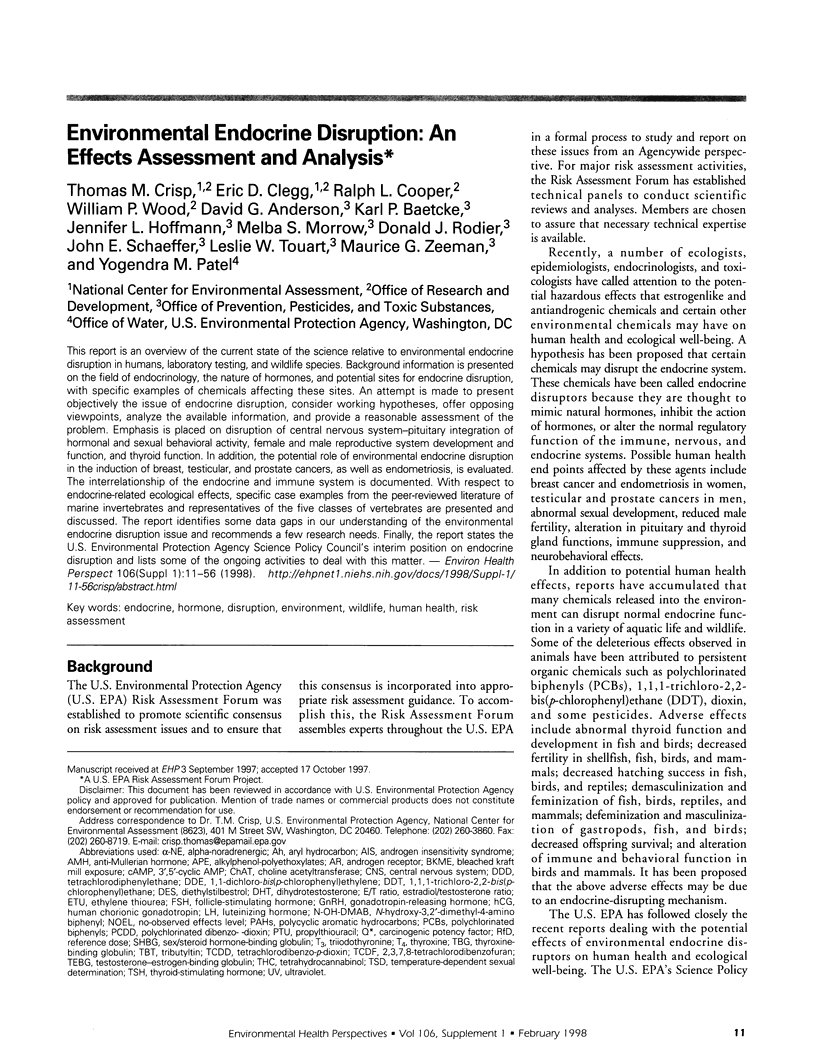
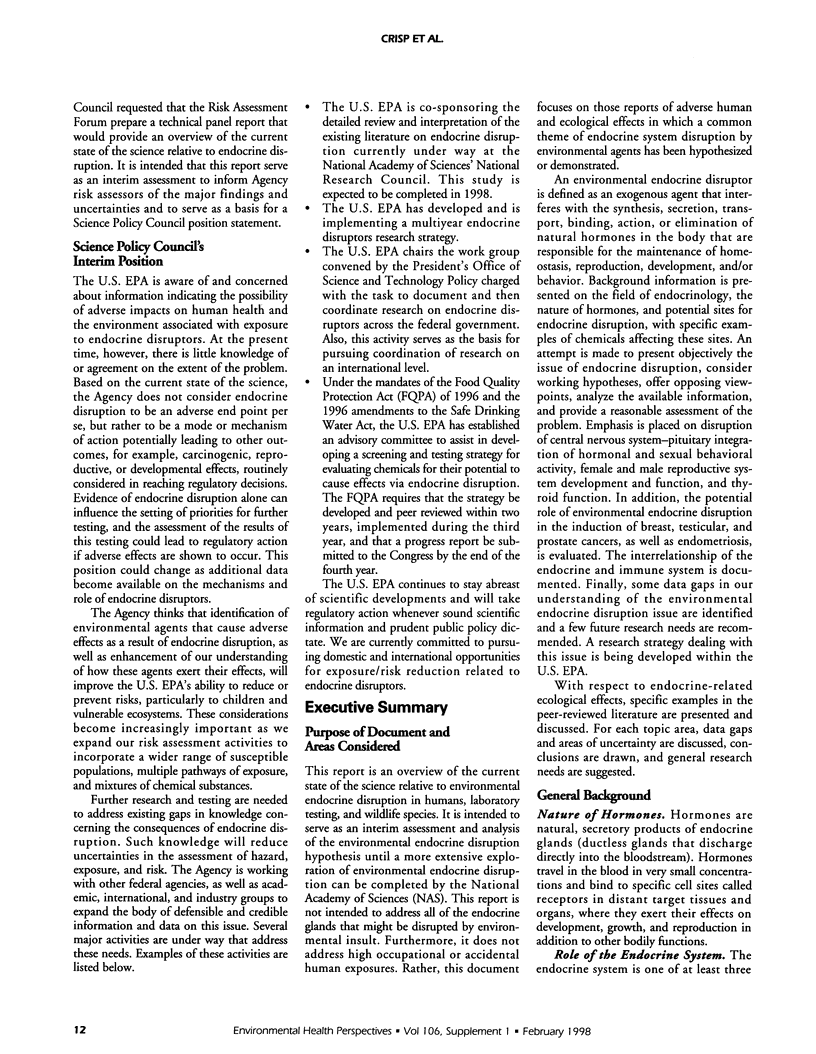
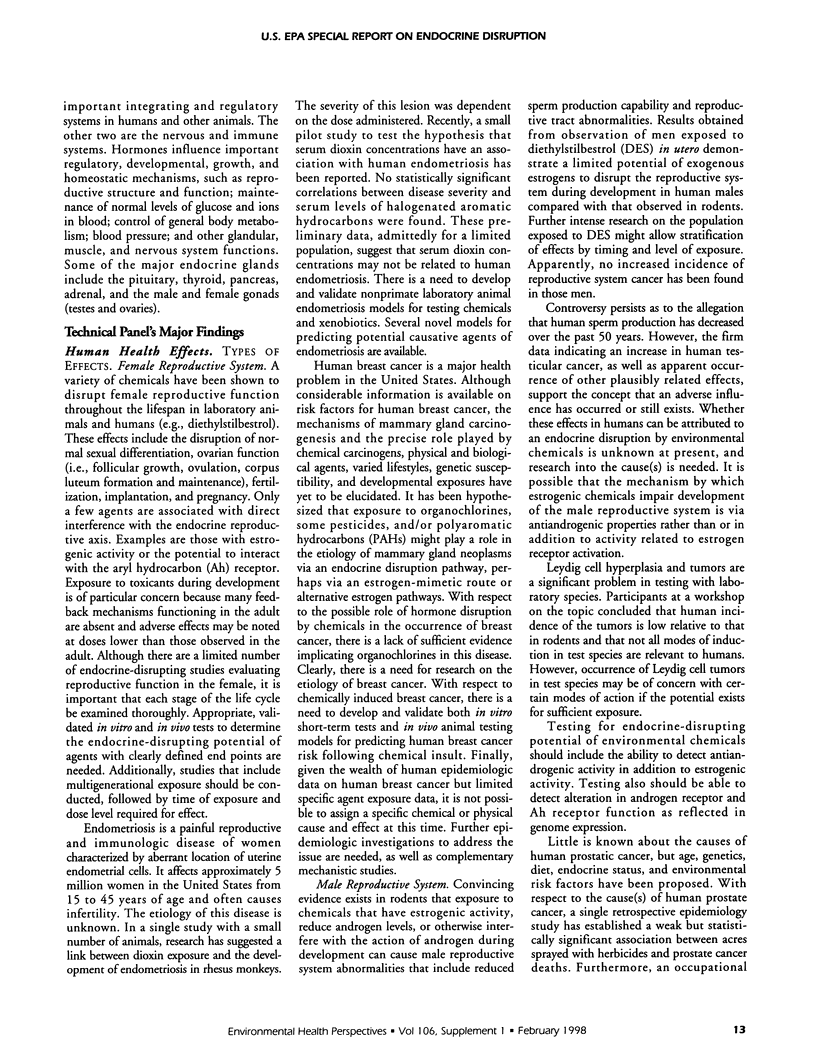
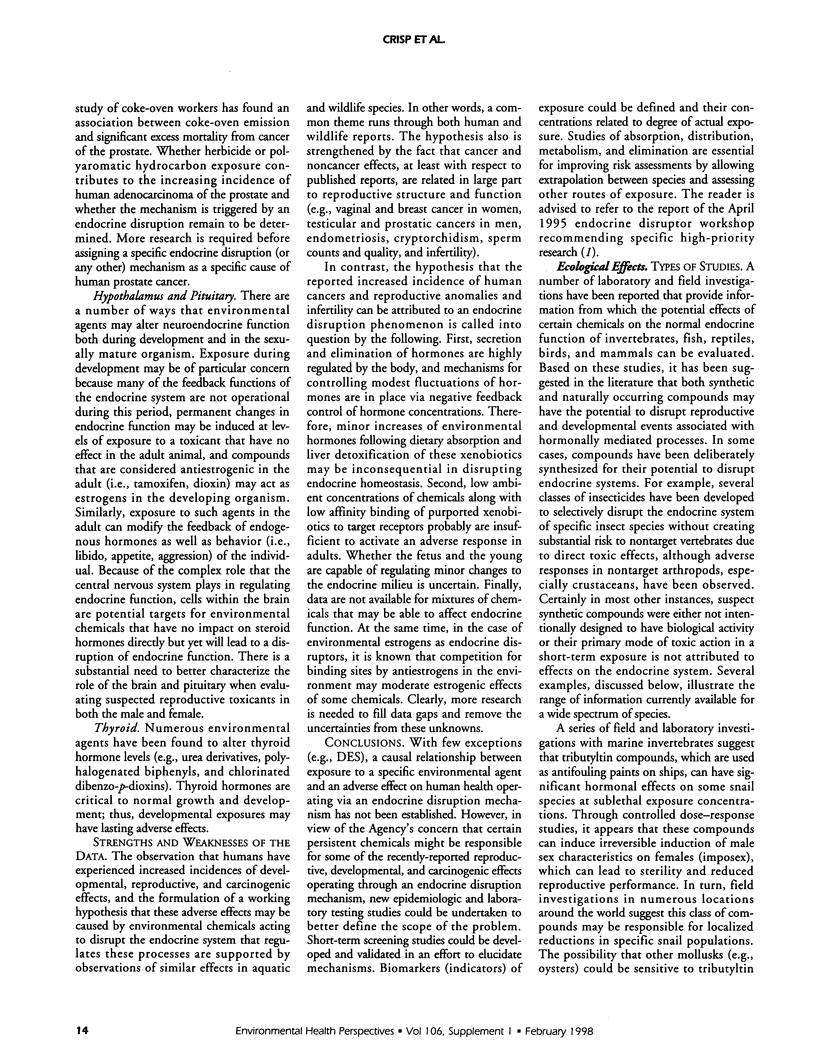
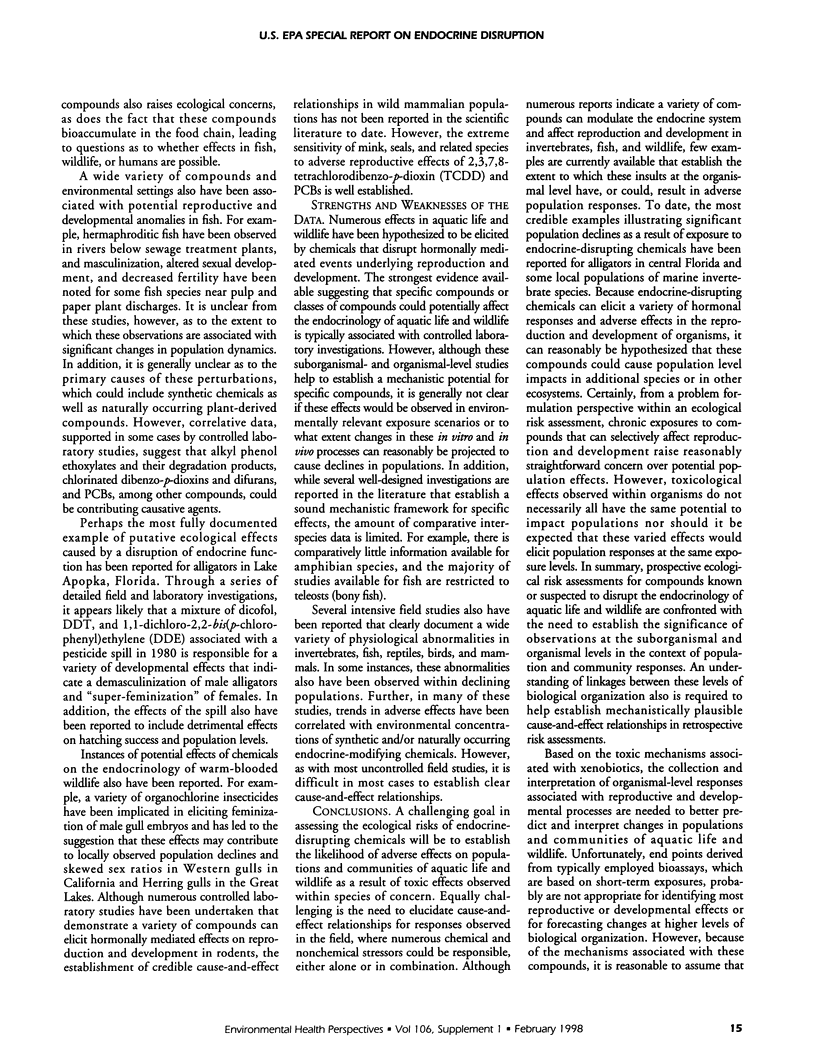
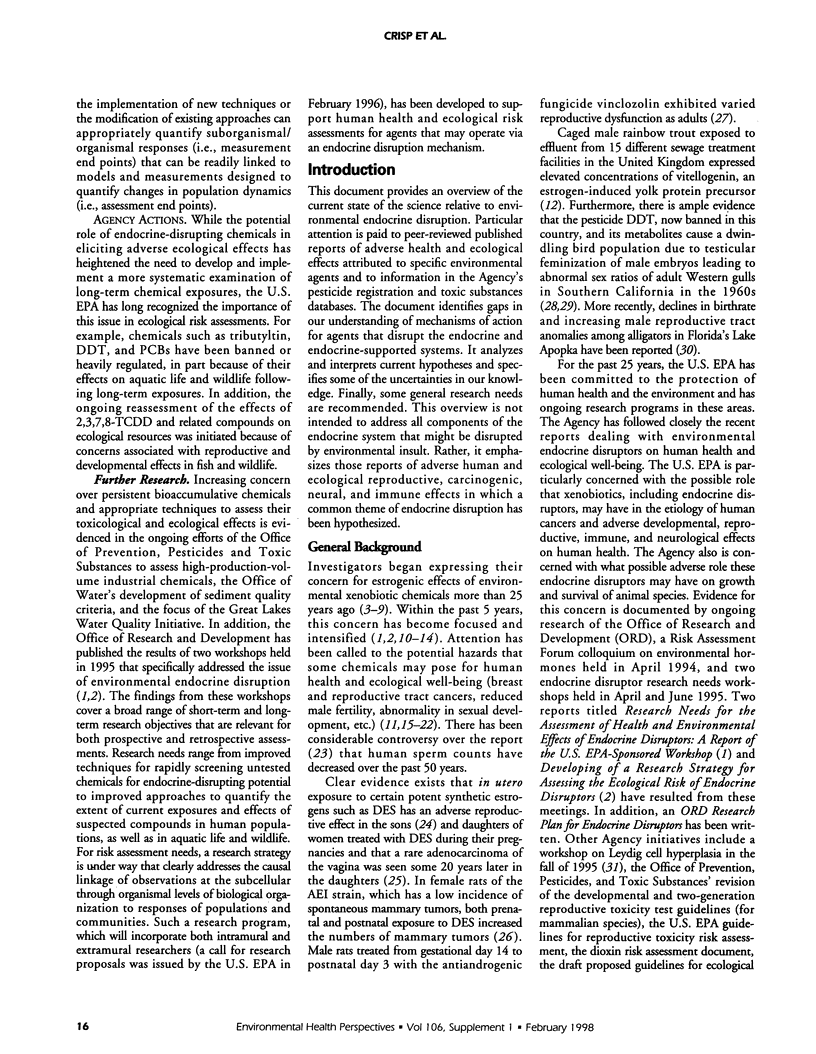
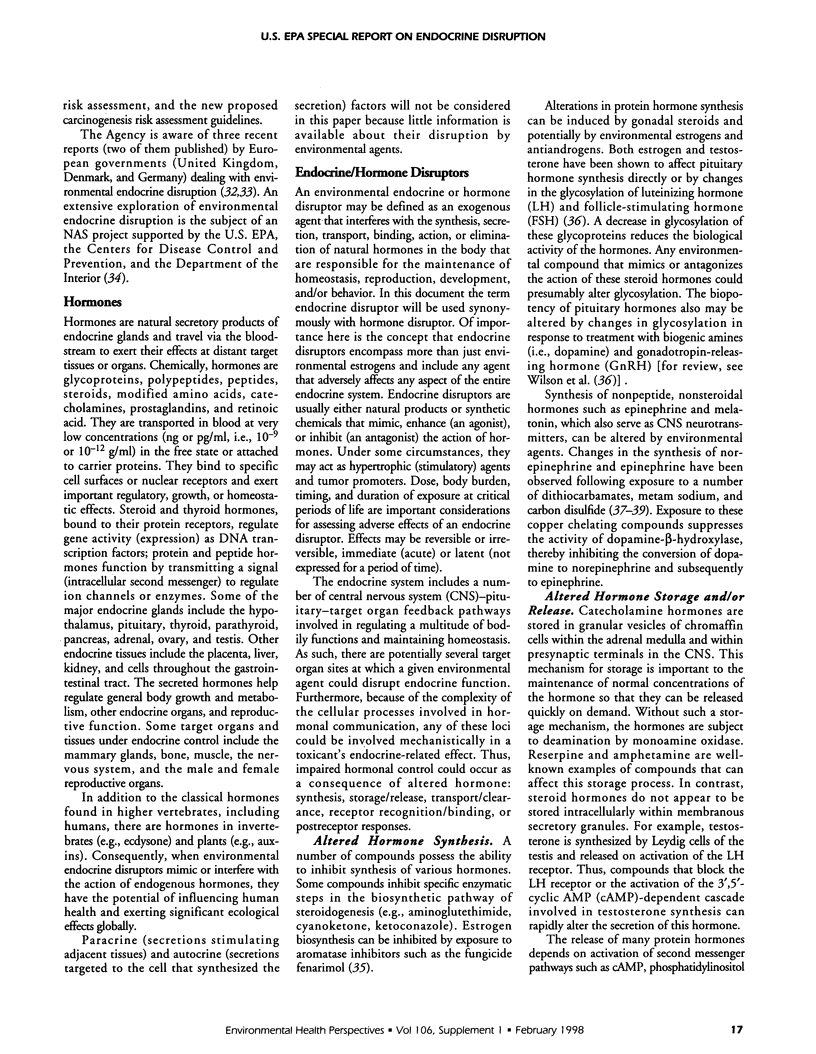
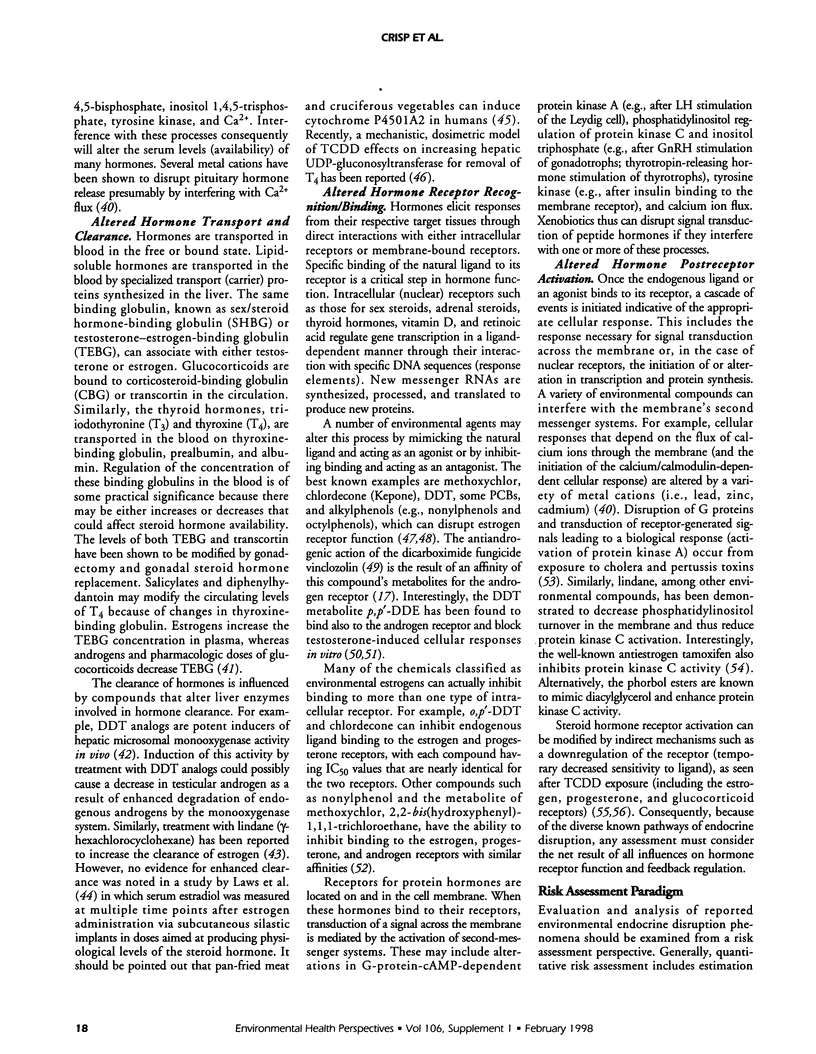
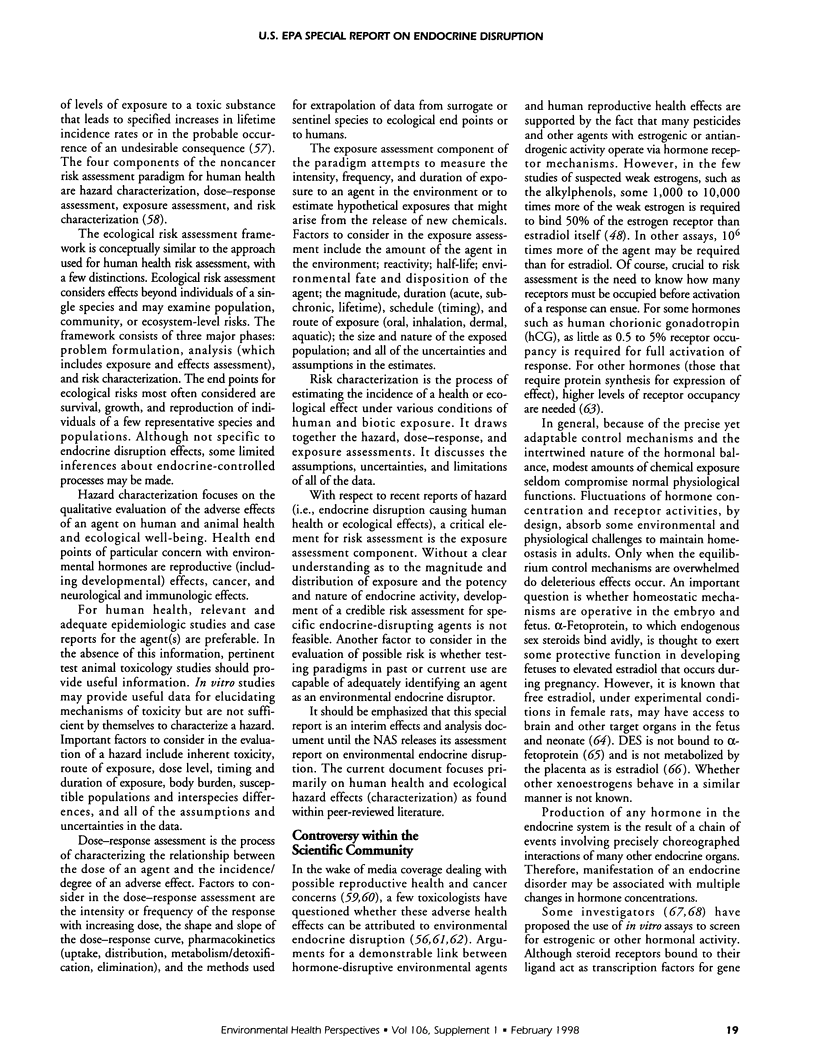
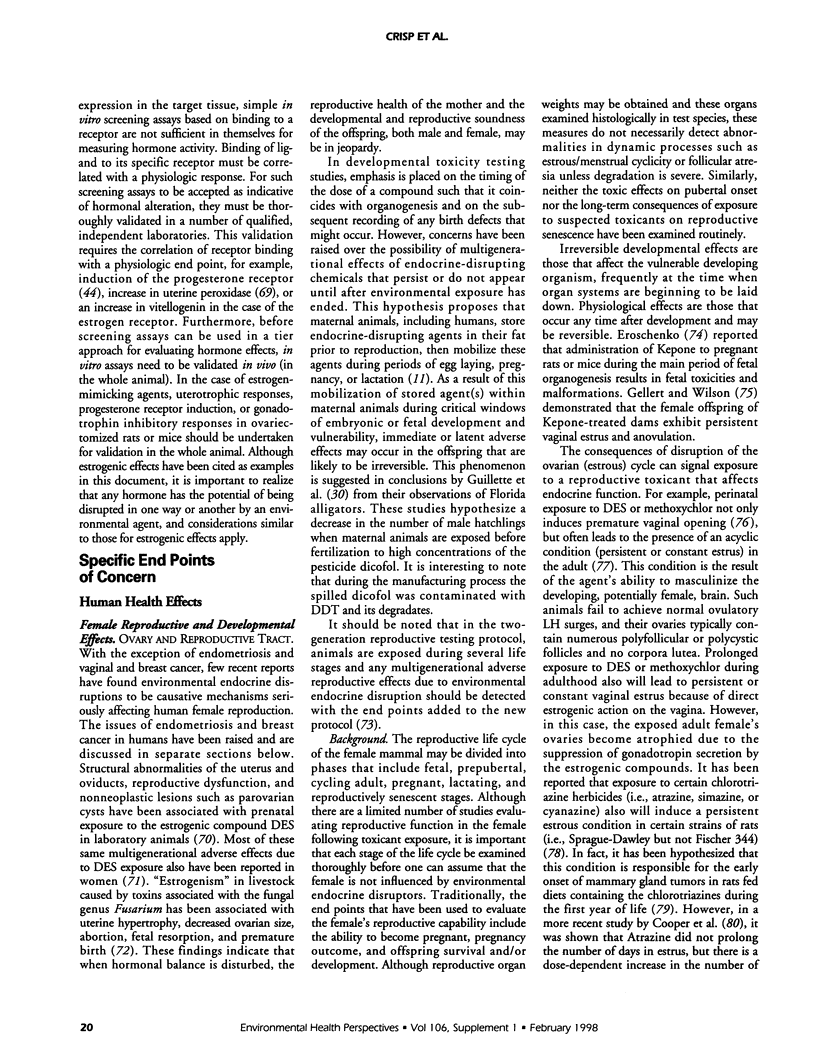
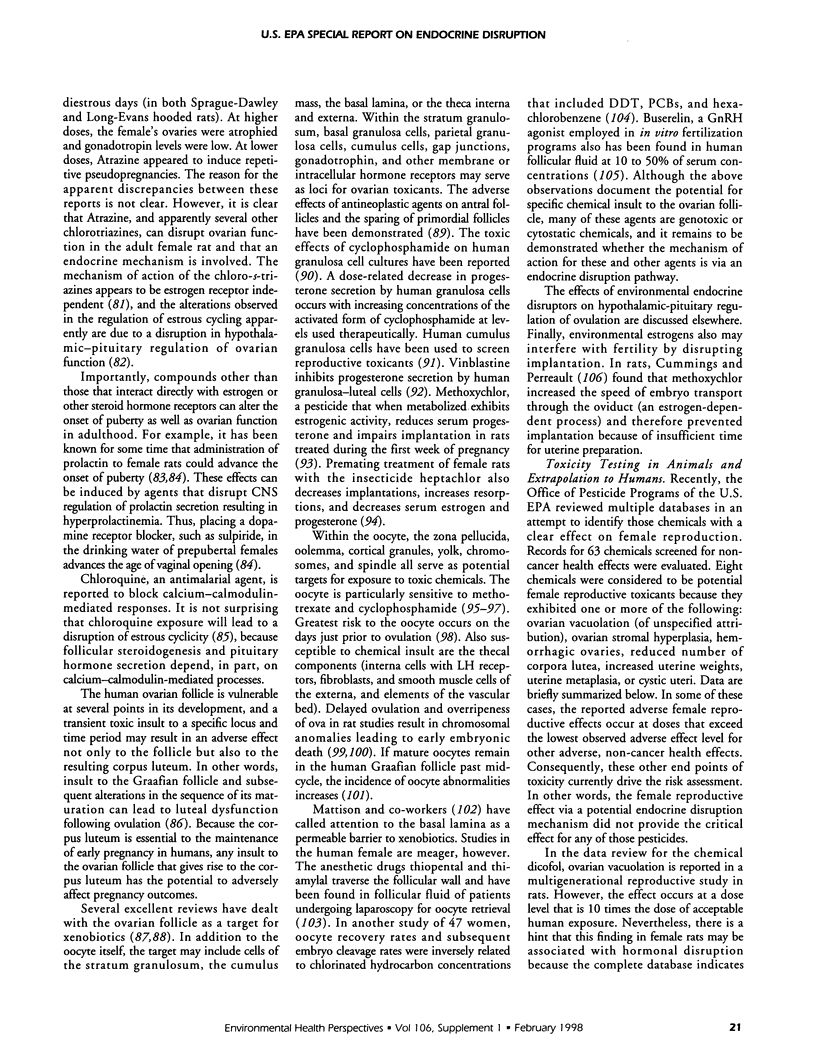
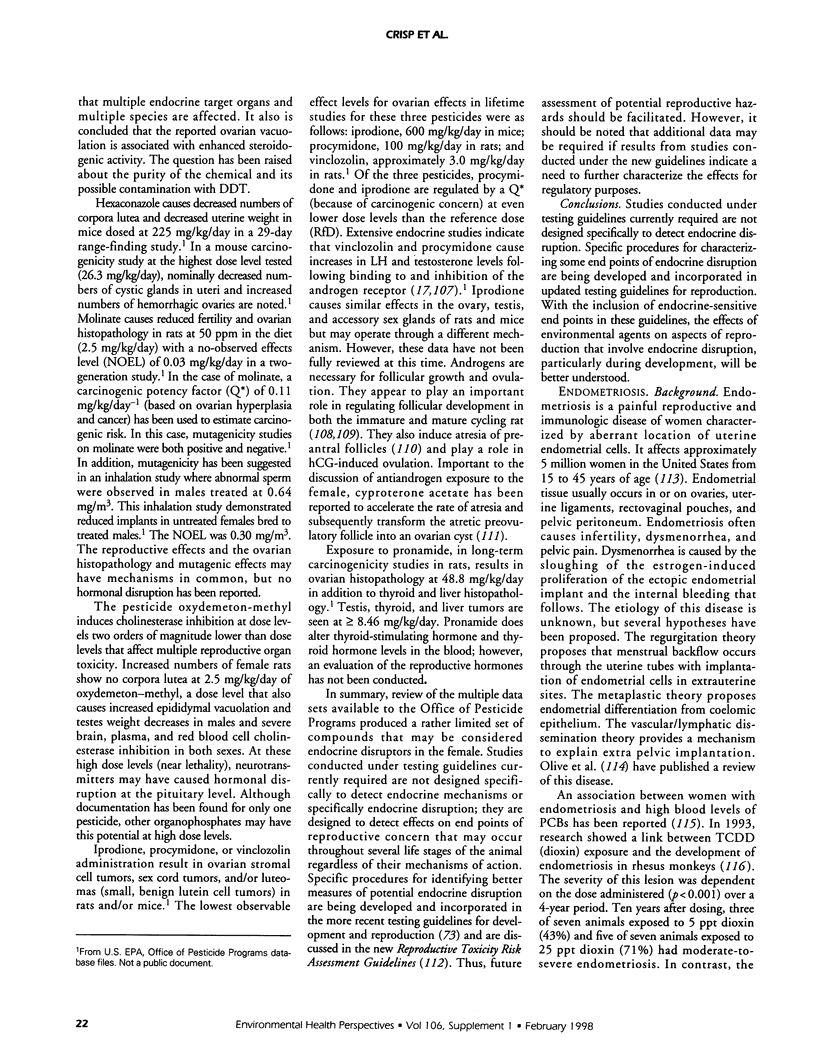
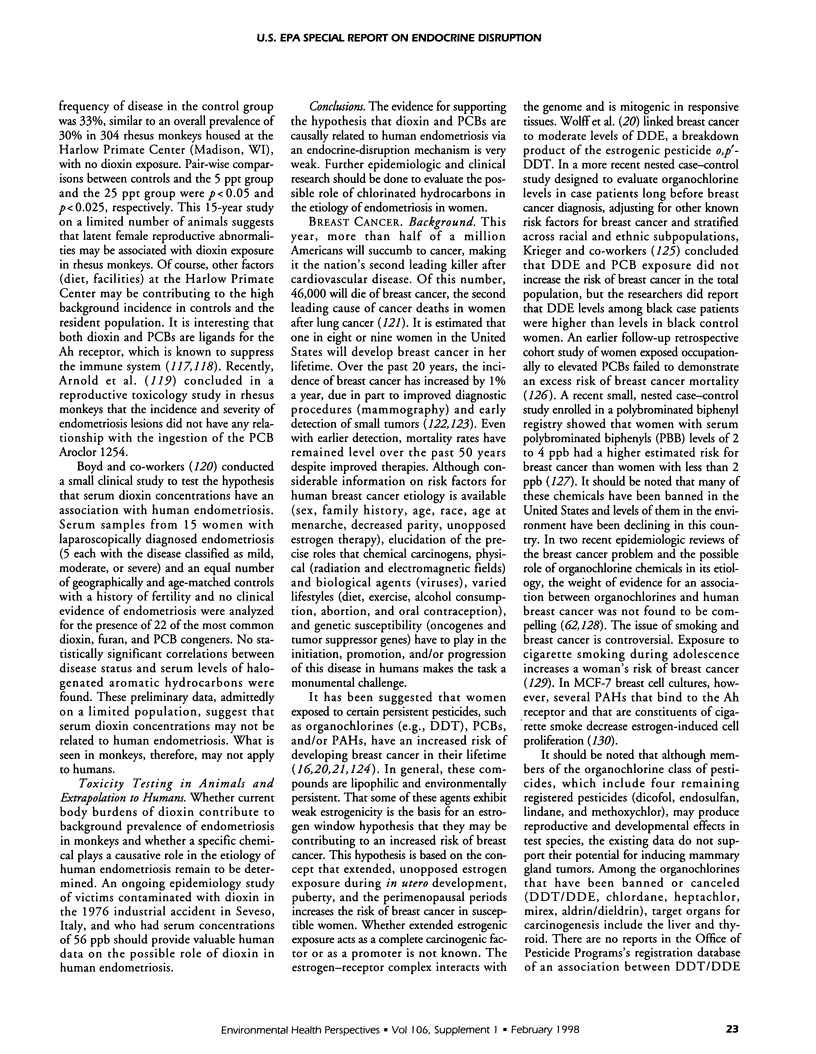
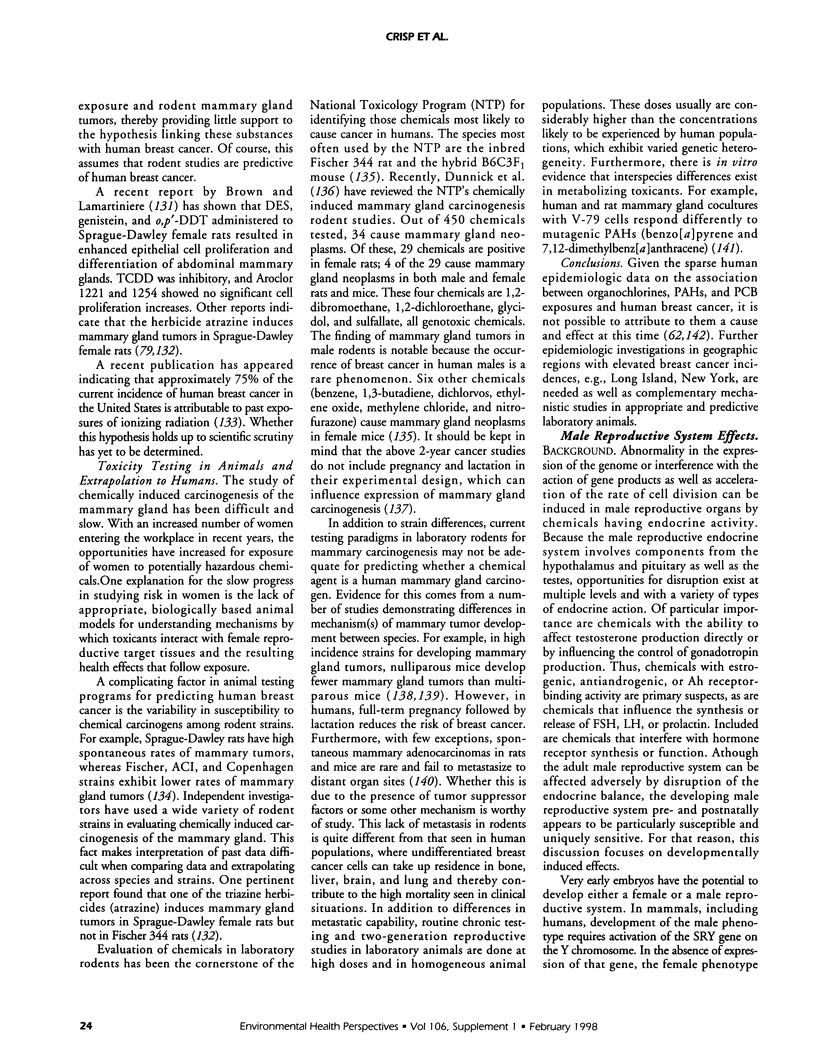
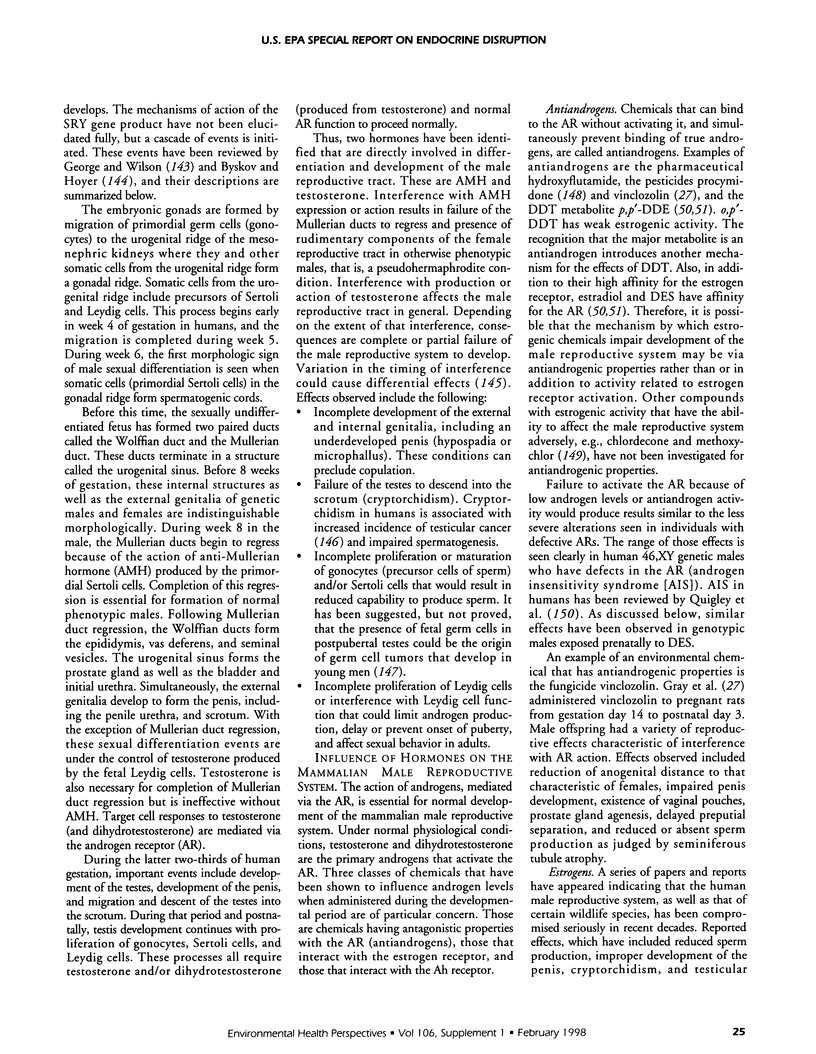
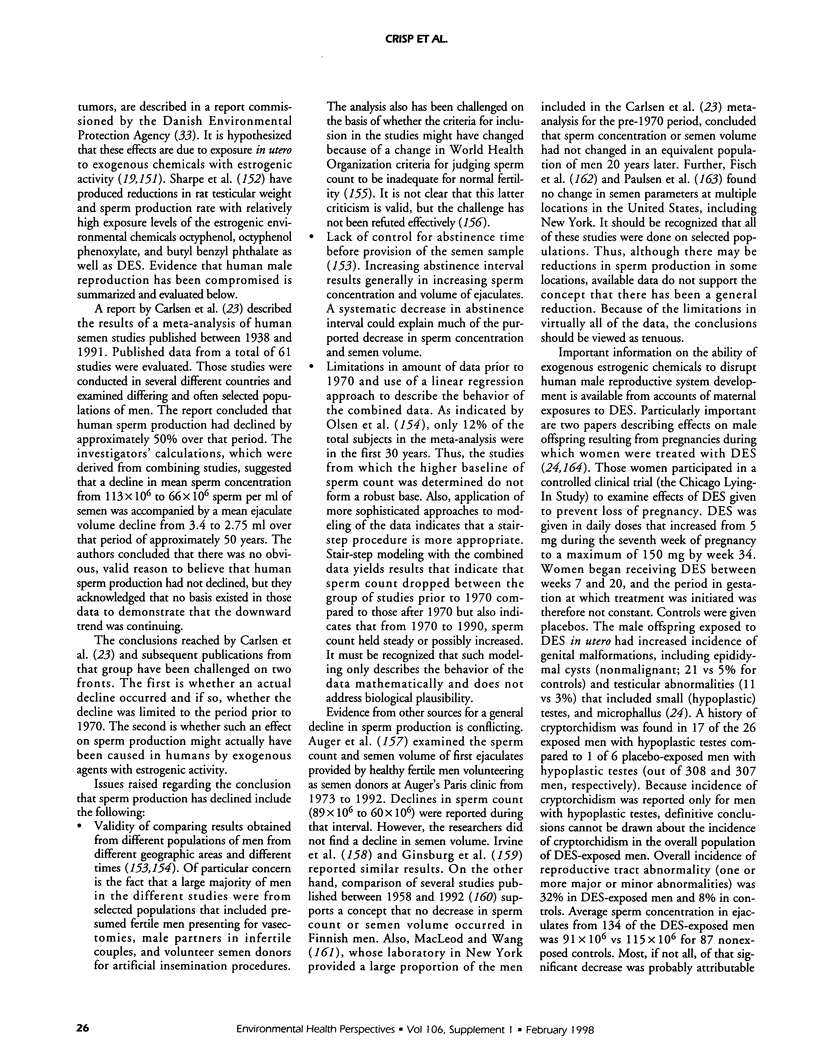
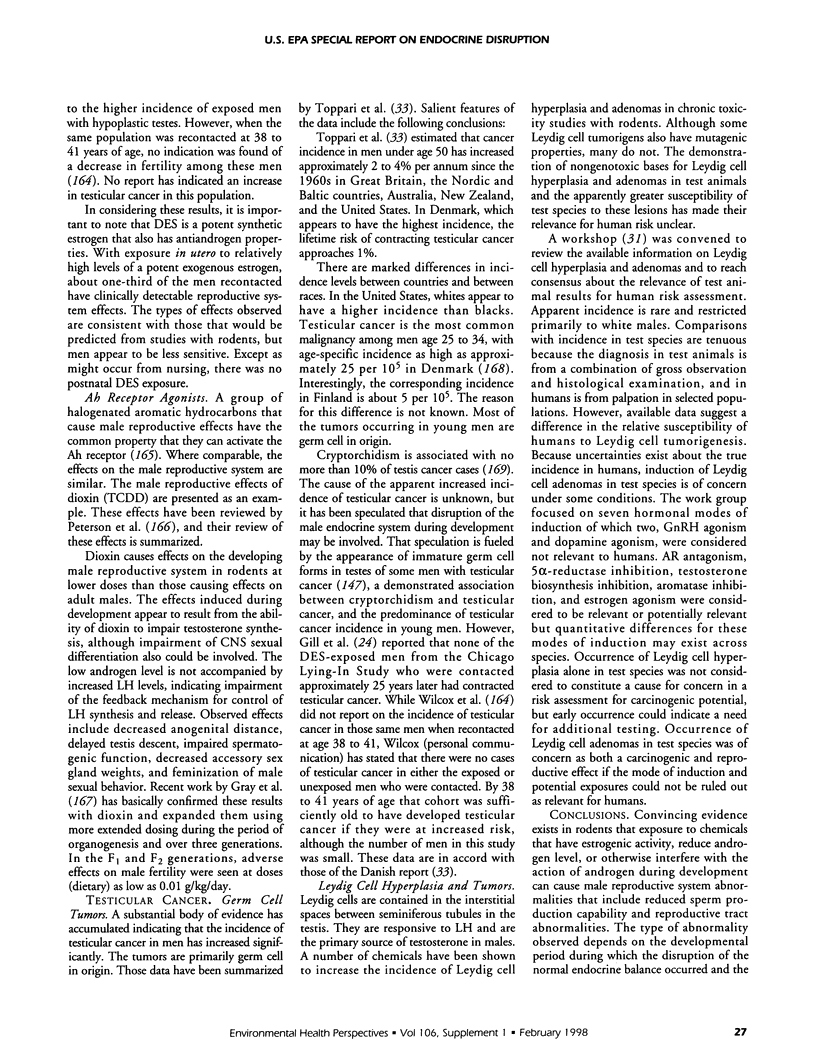
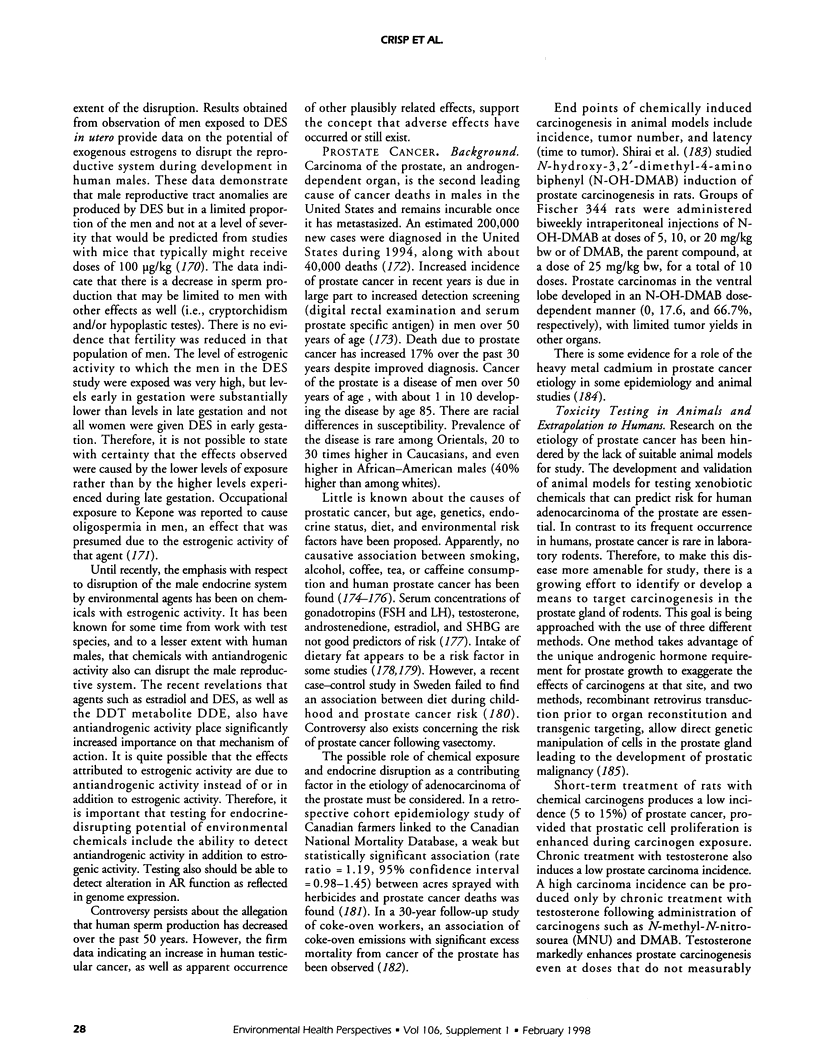
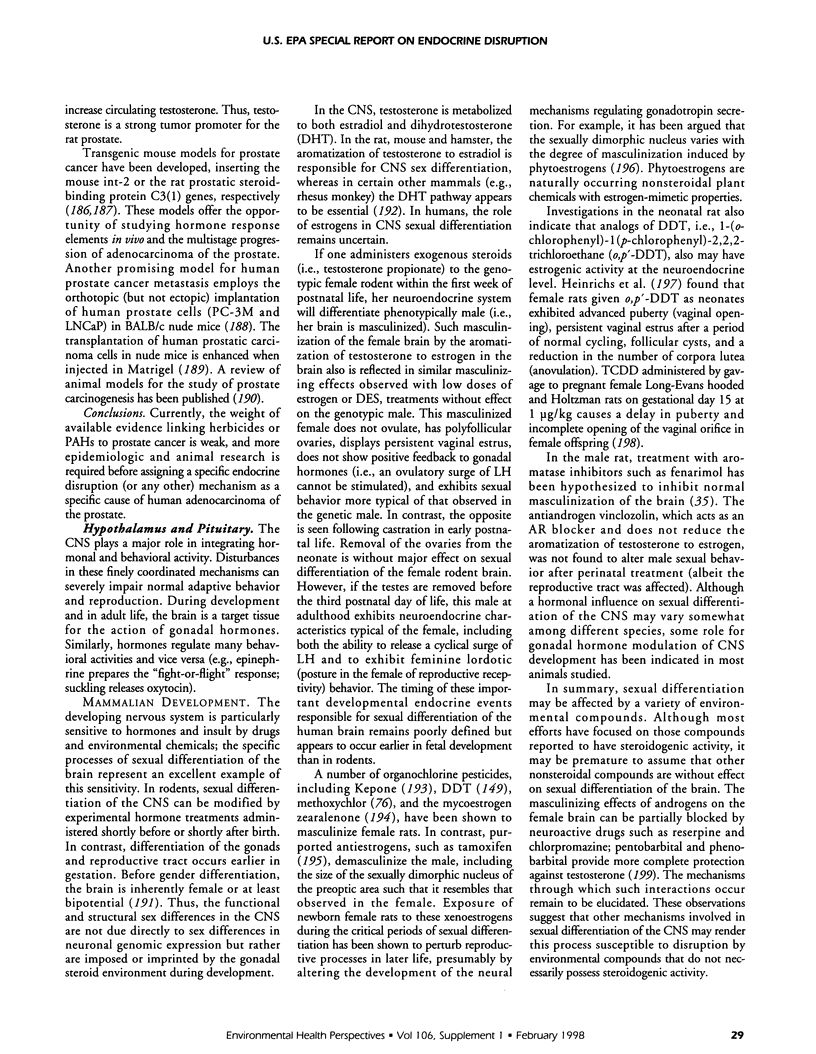
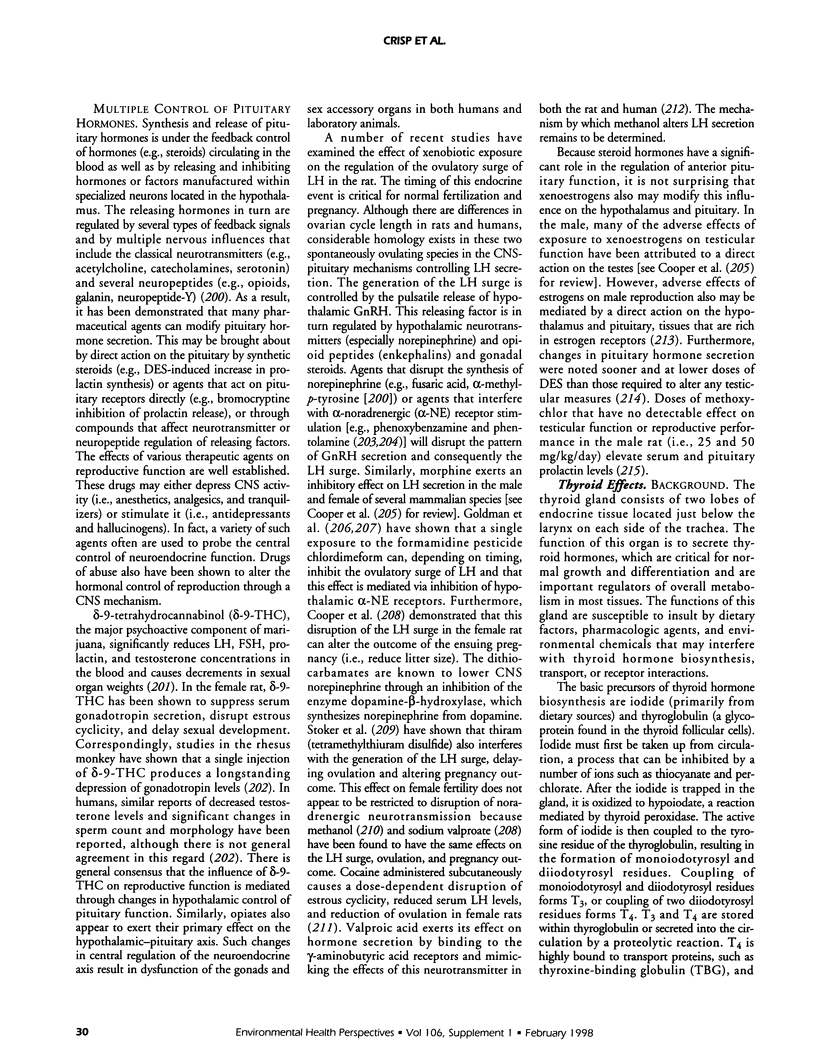
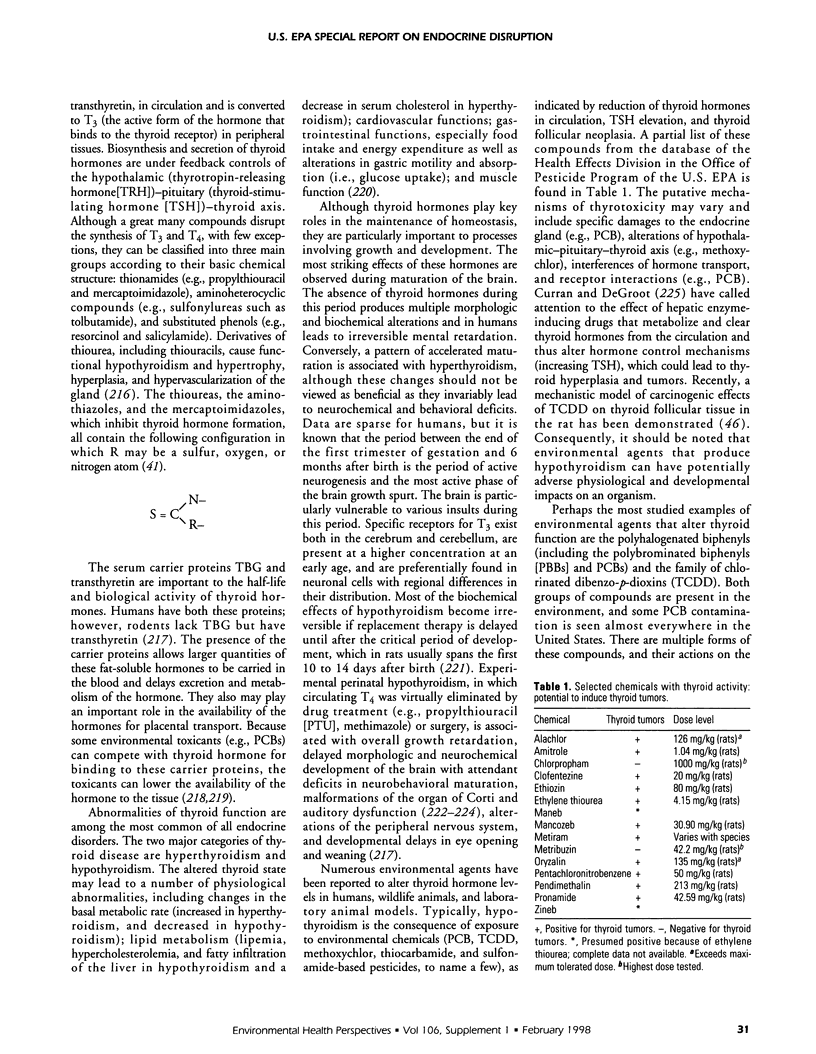
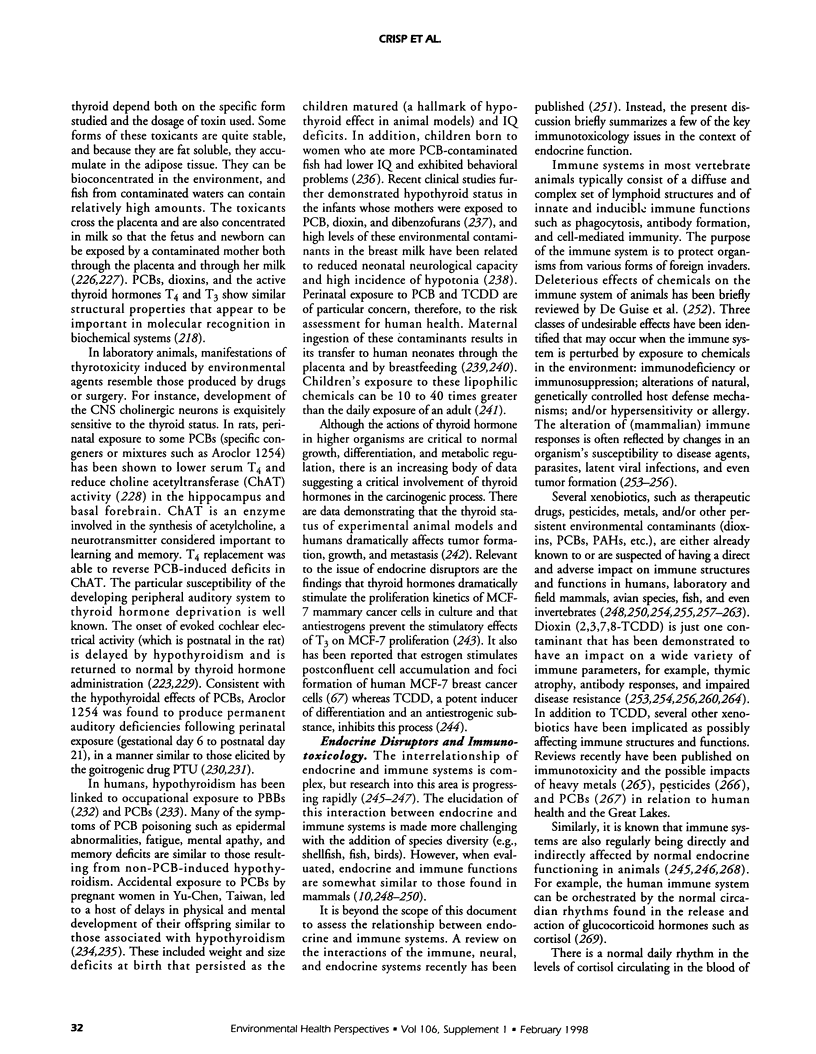
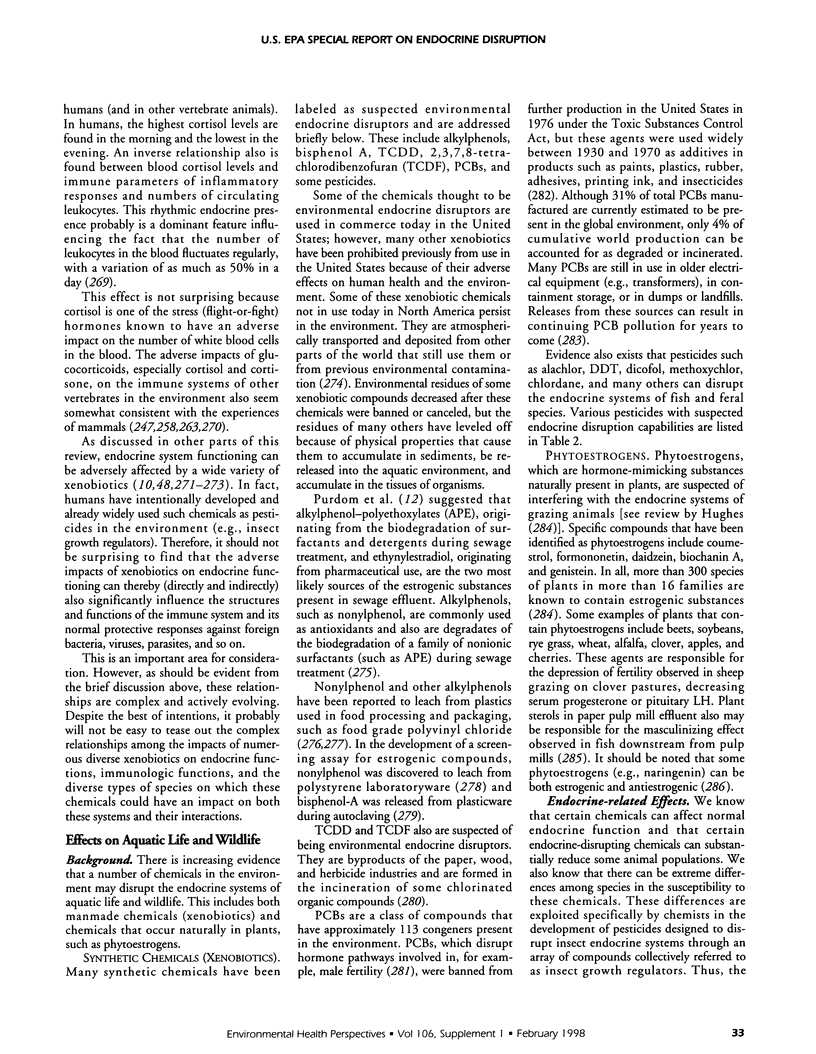
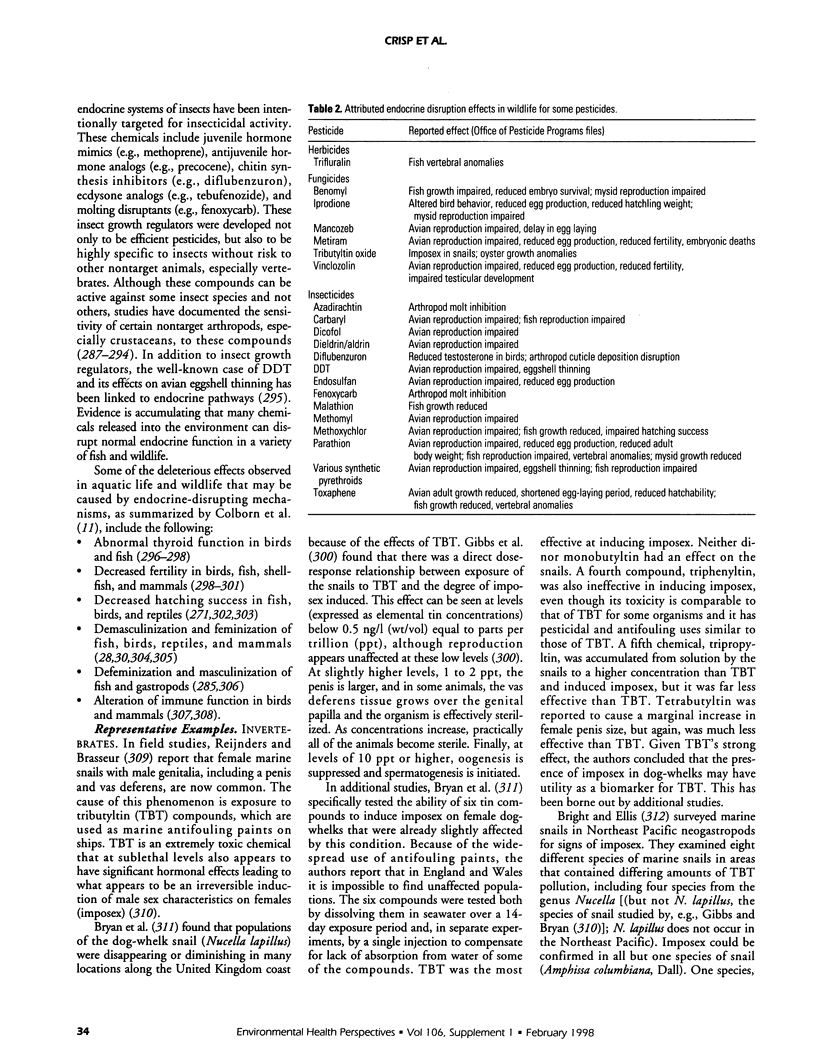

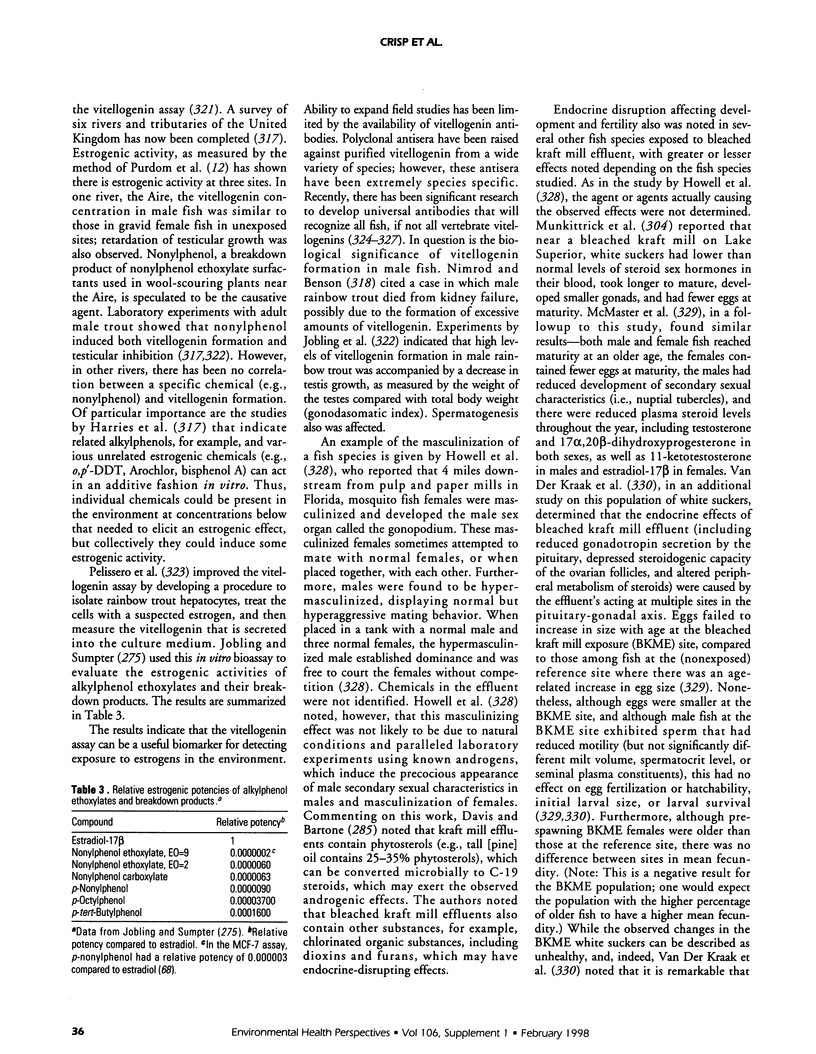
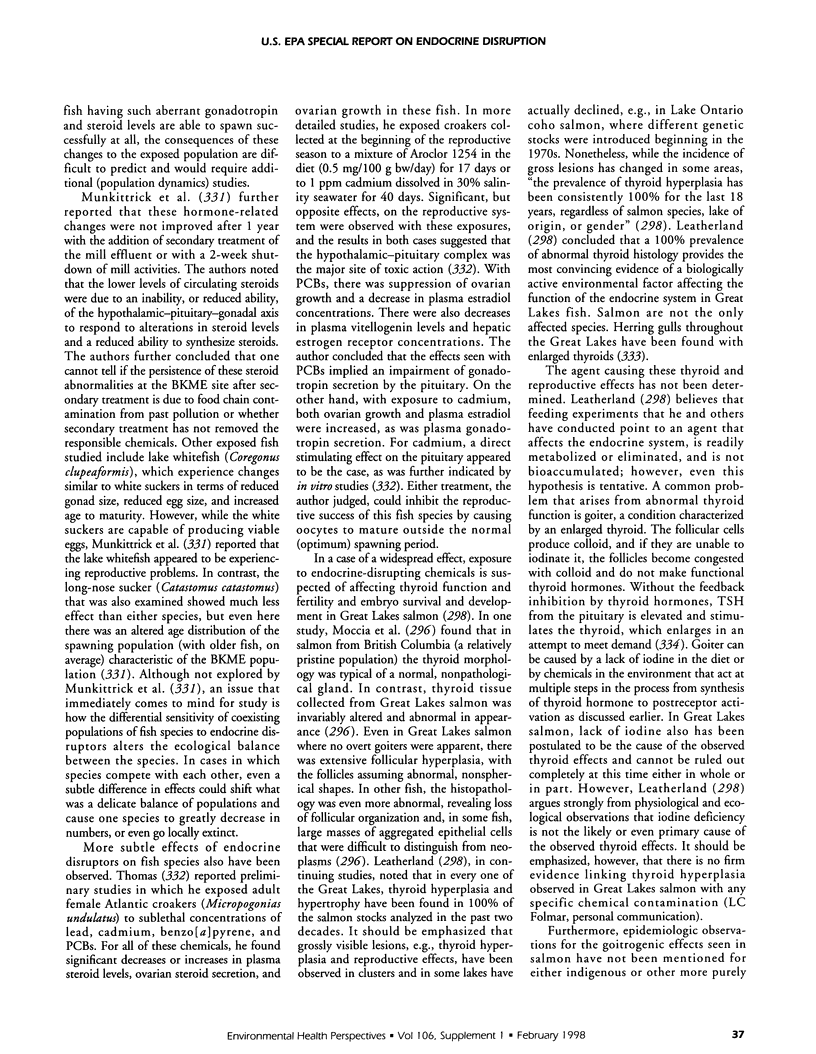
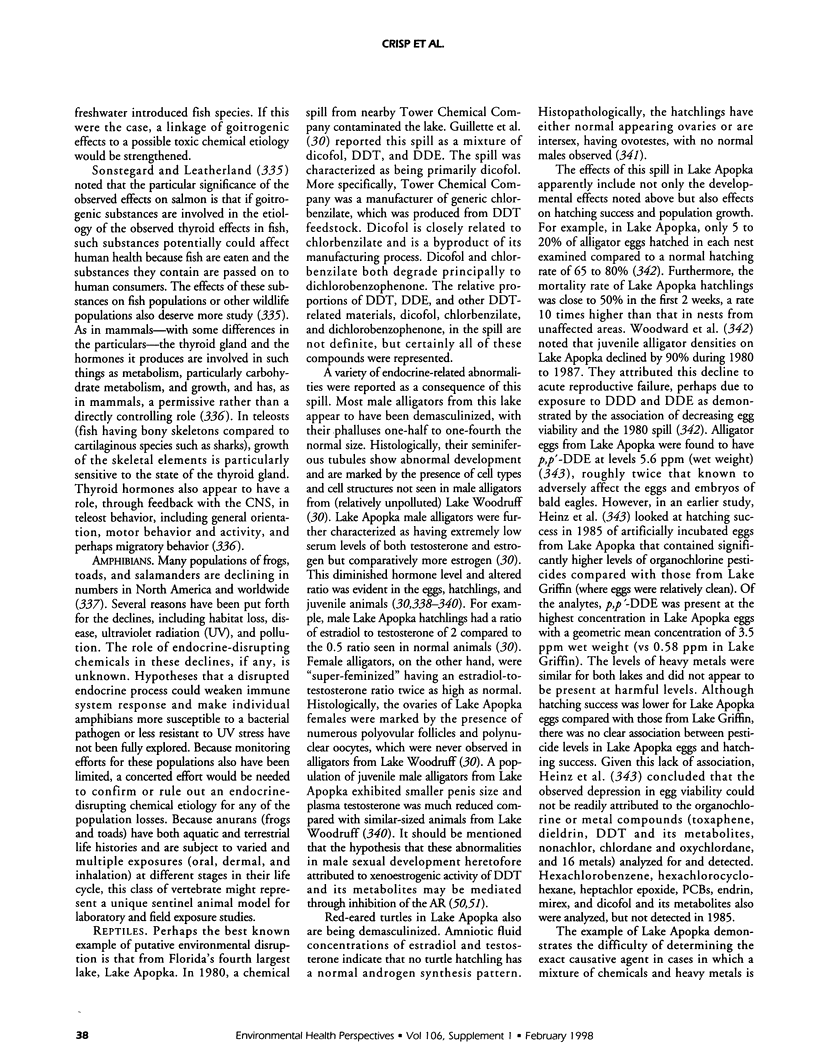

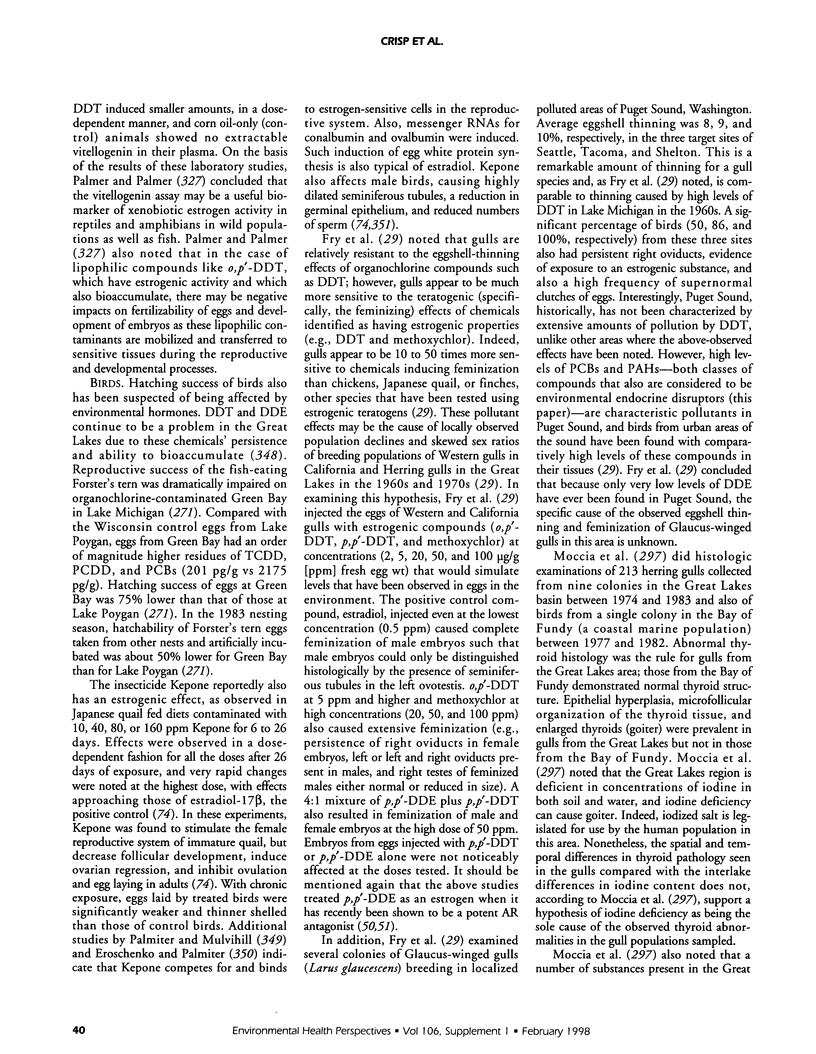
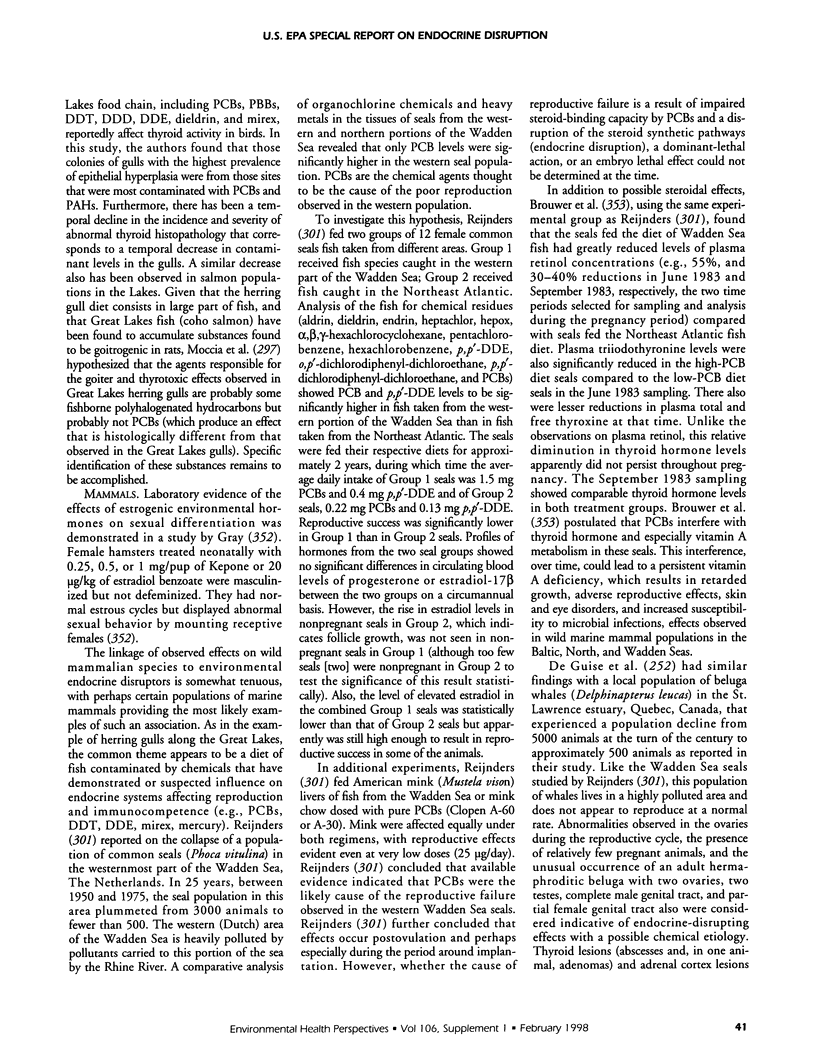
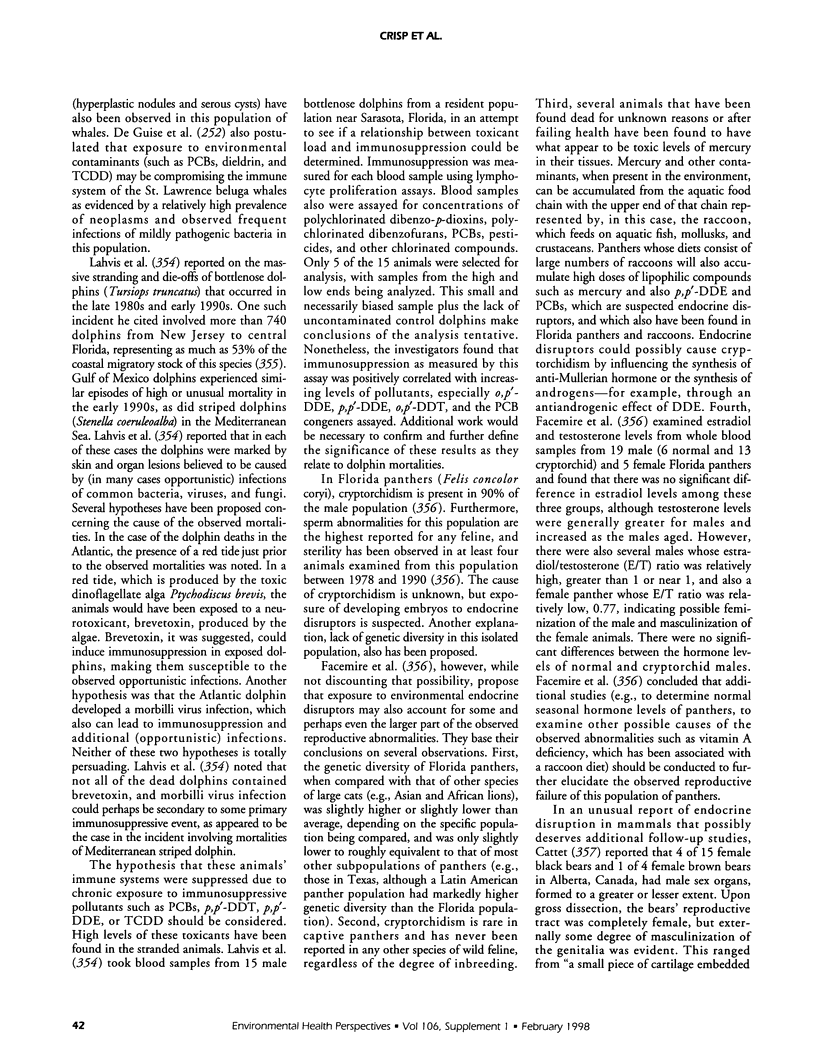
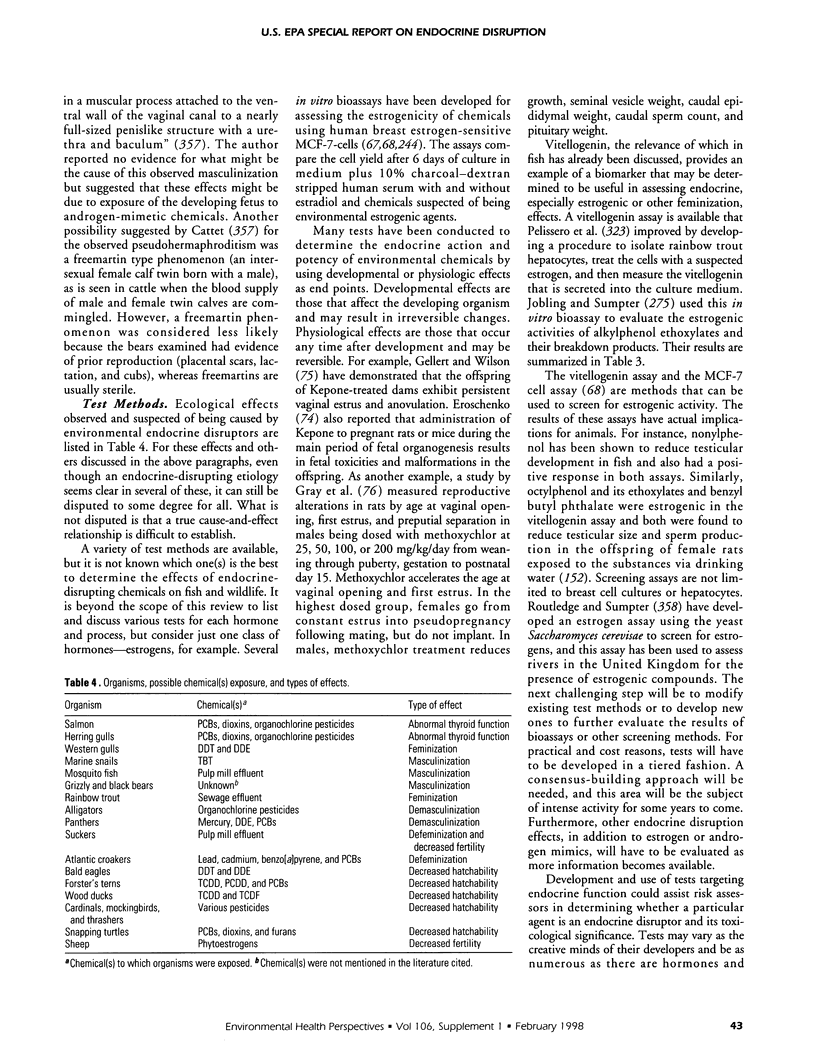
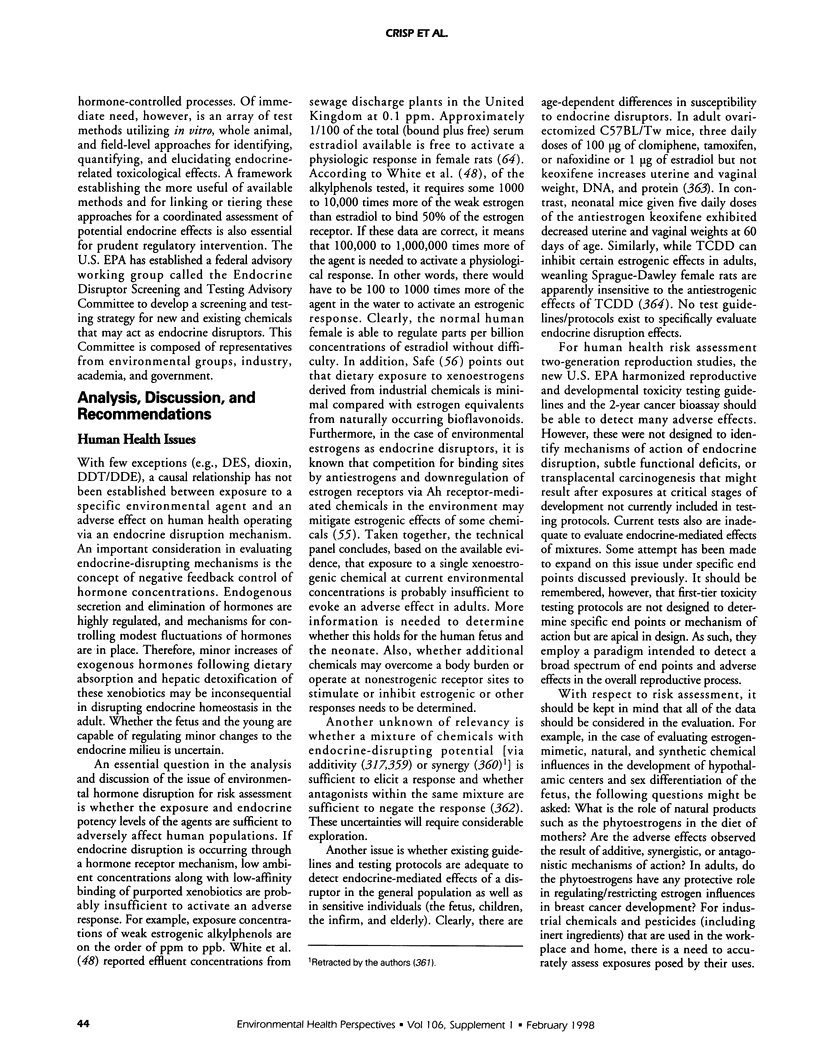
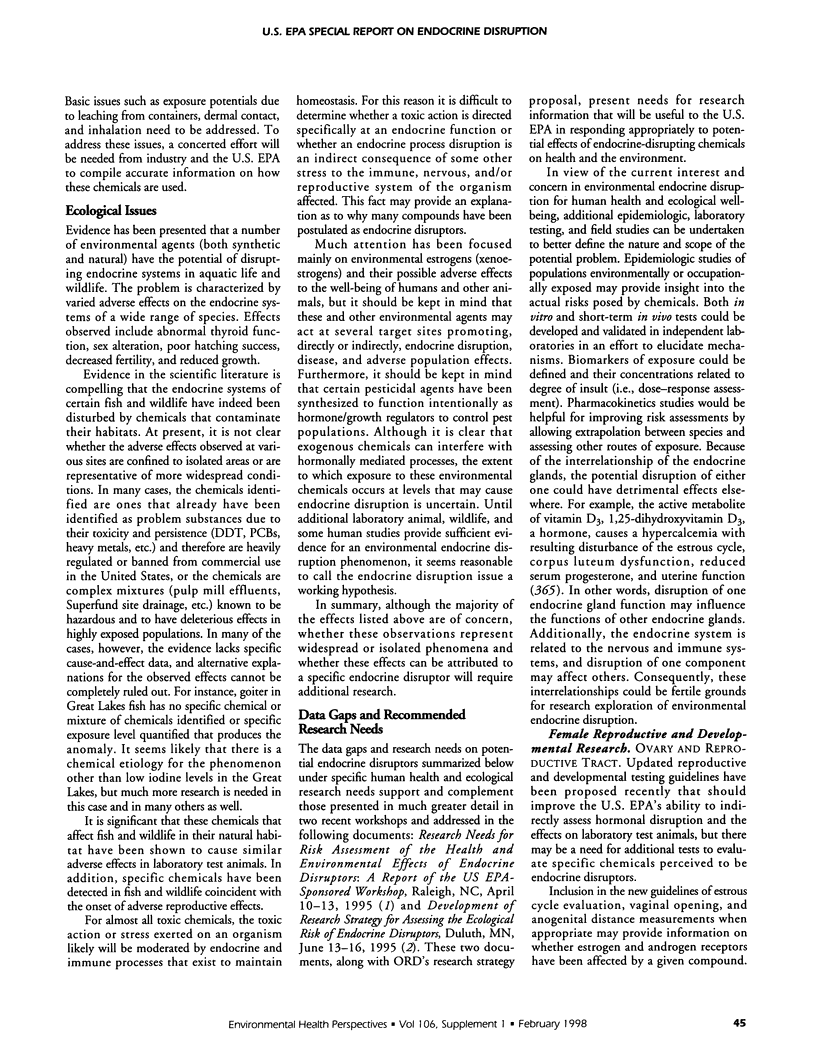
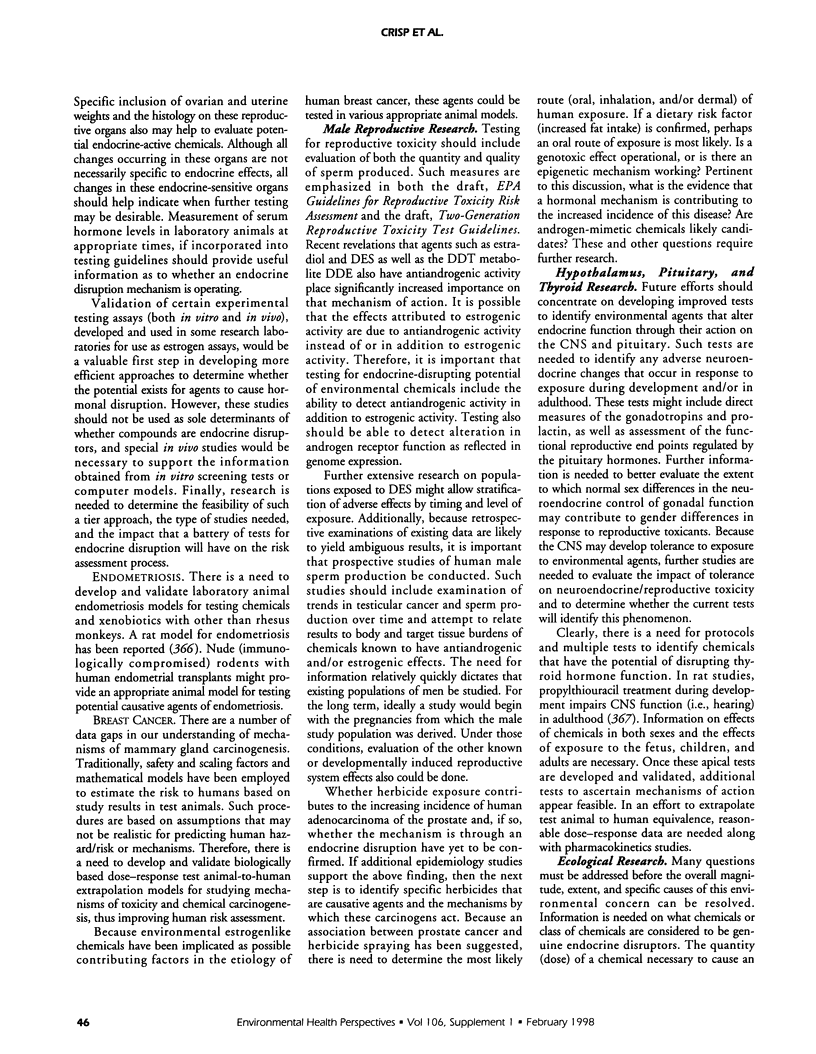

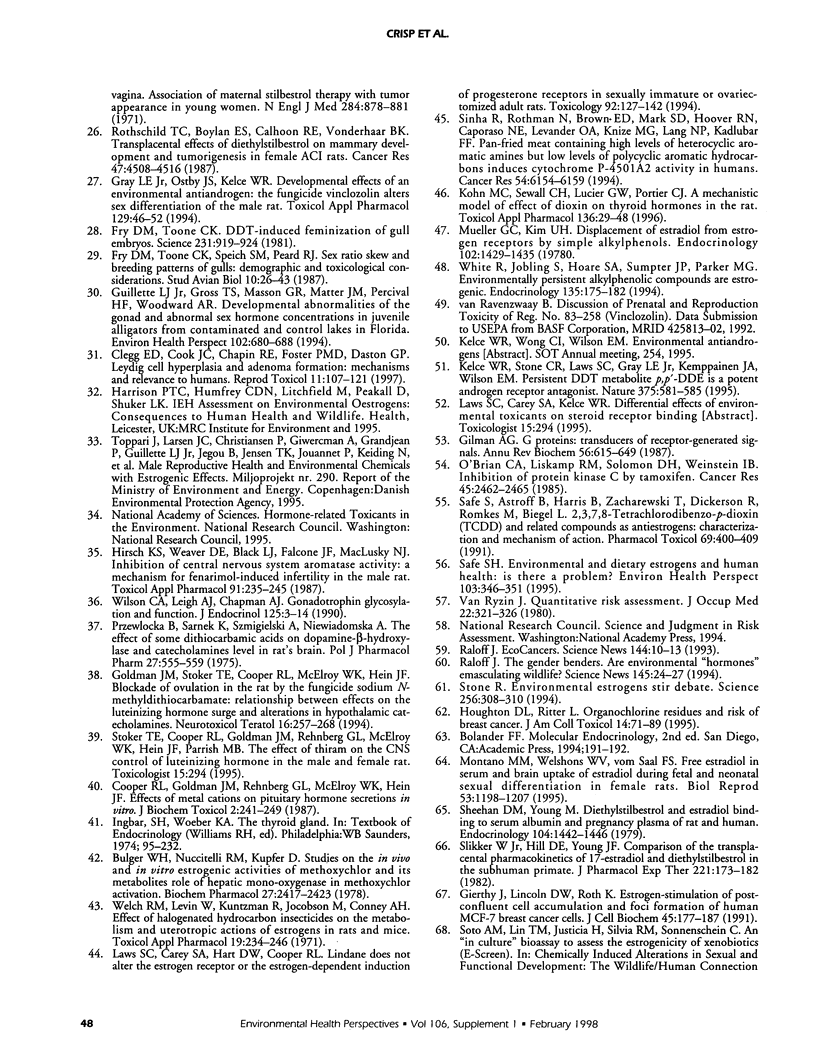

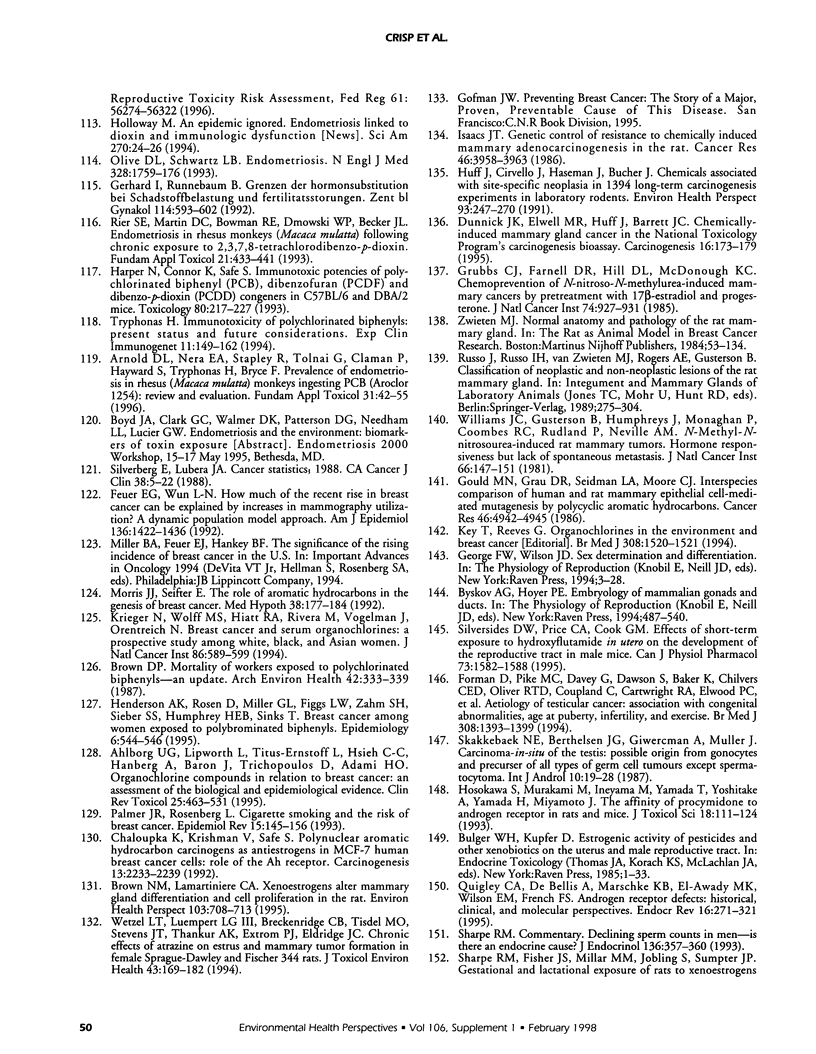
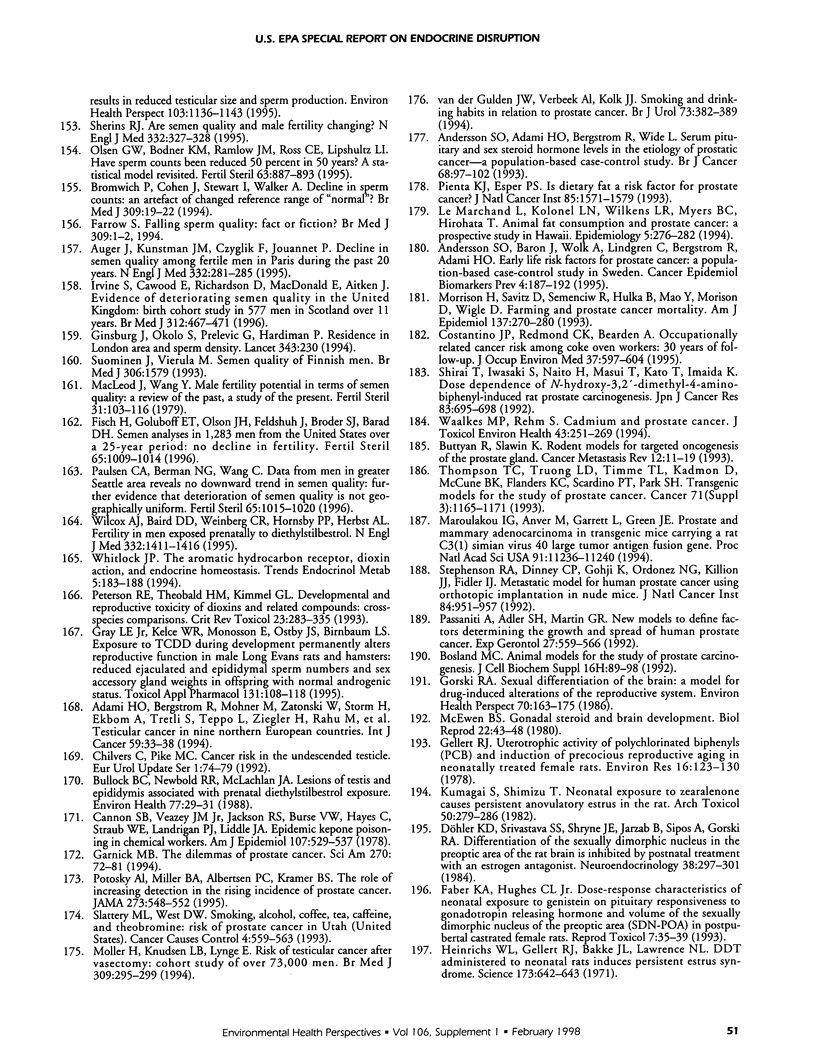
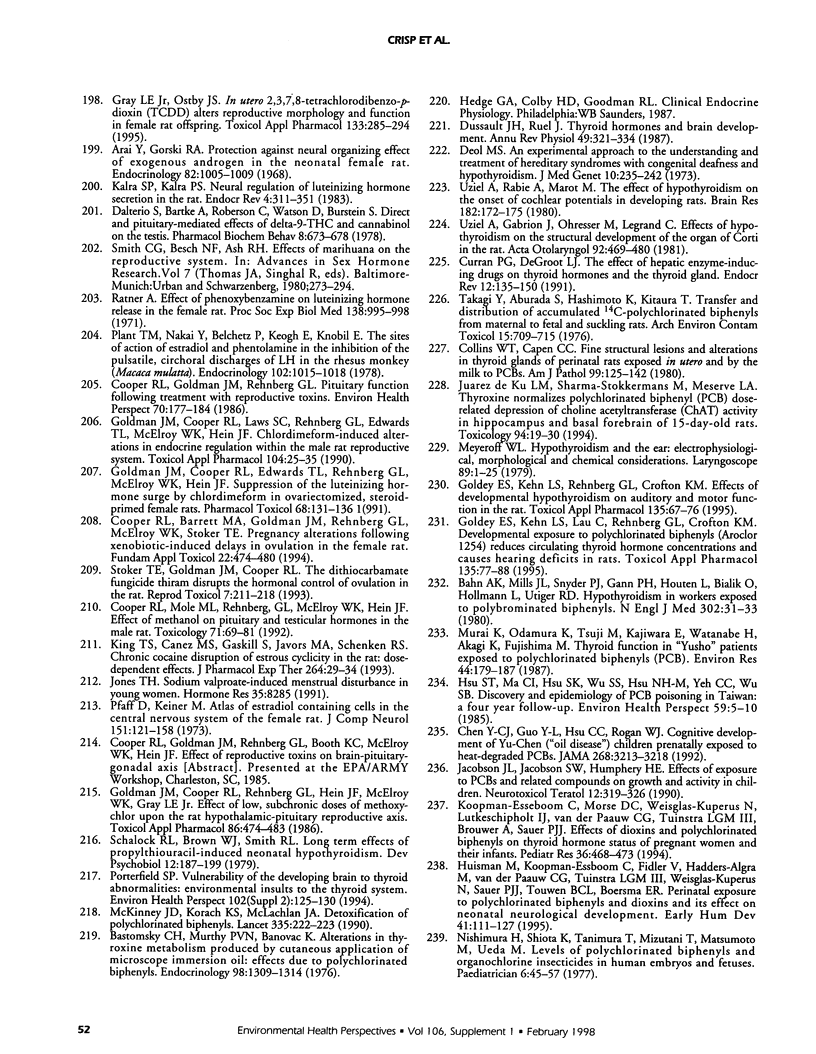
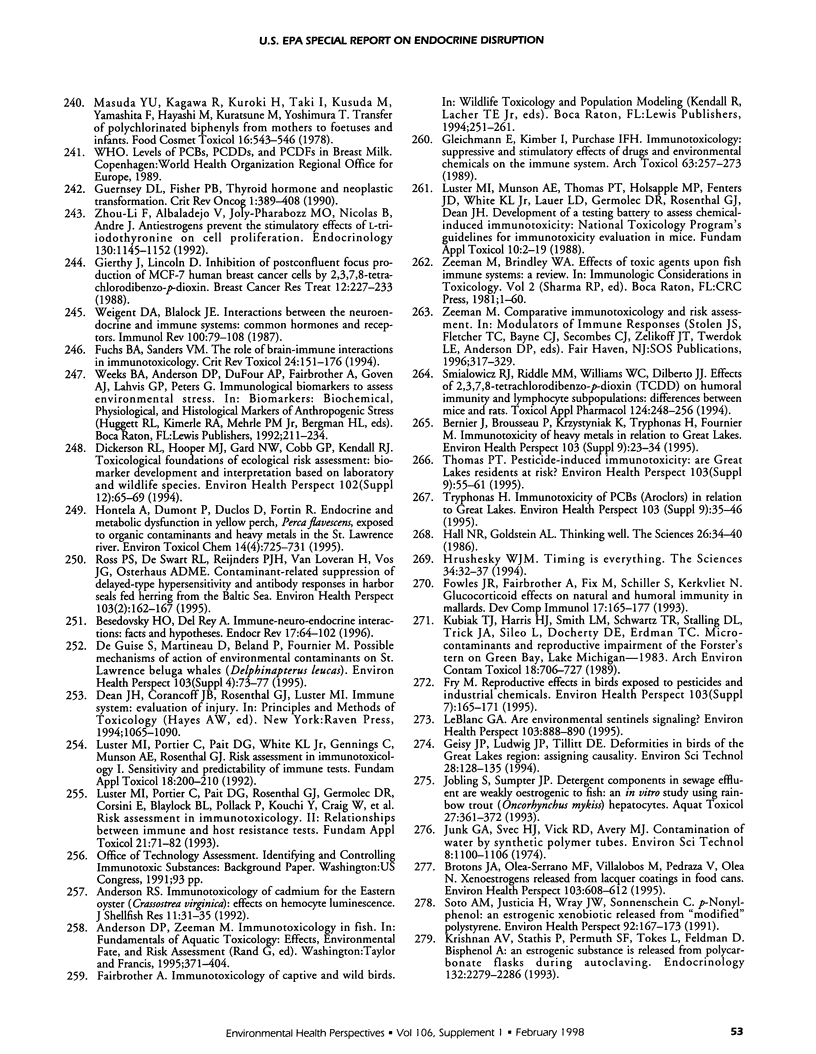
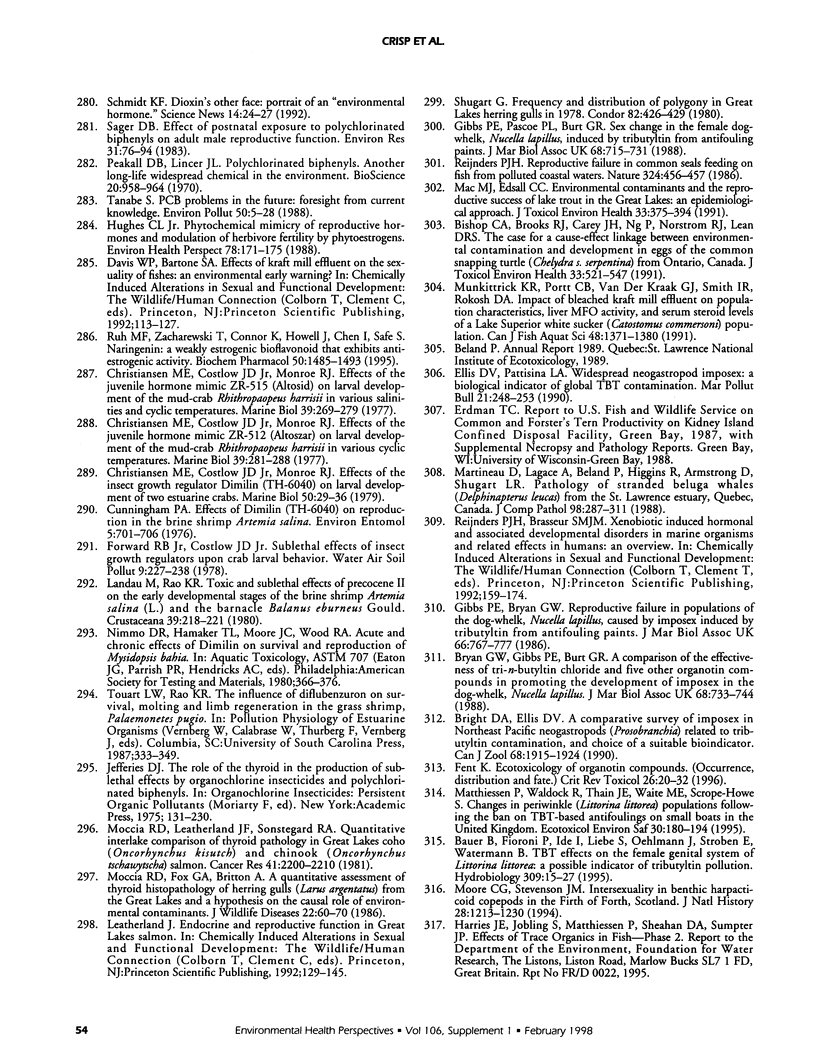
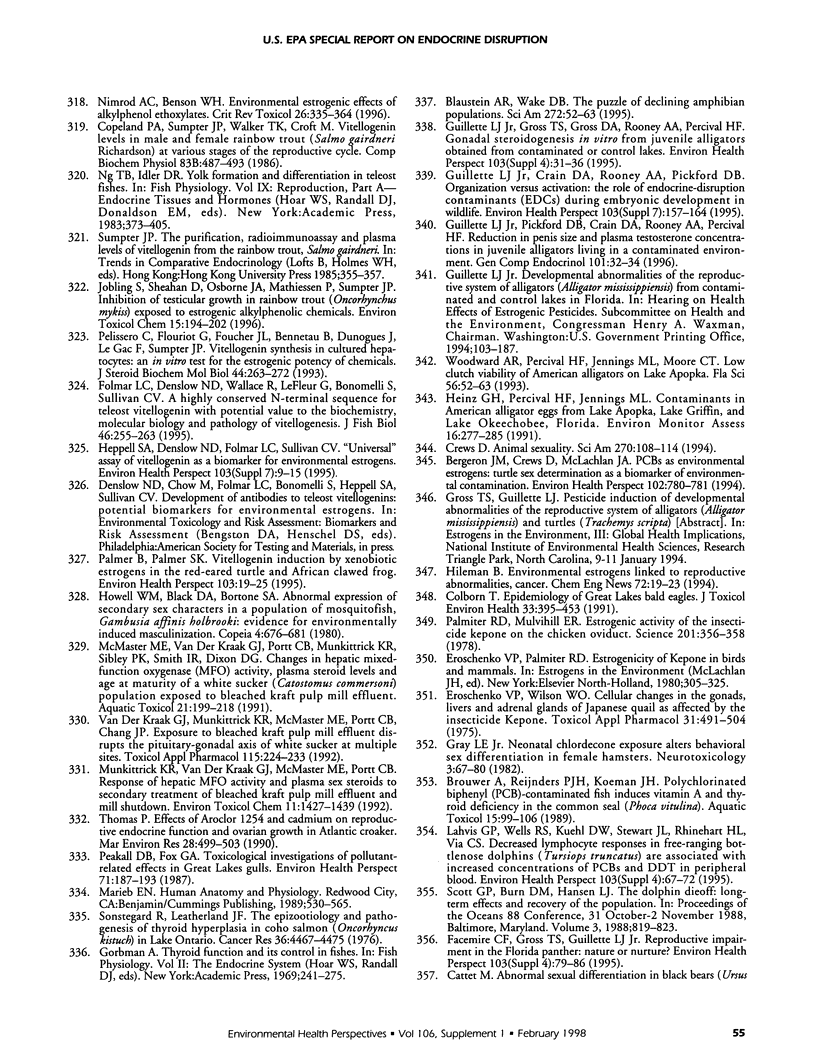
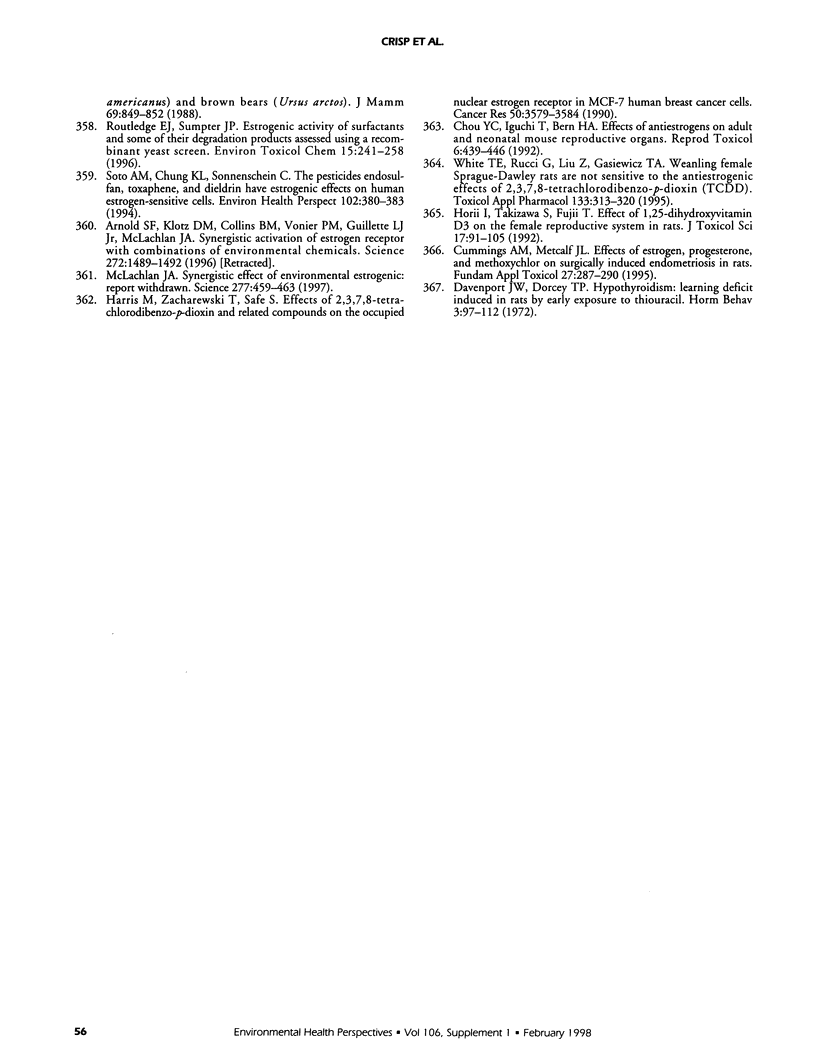
Selected References
These references are in PubMed. This may not be the complete list of references from this article.
- Adami H. O., Bergström R., Möhner M., Zatoński W., Storm H., Ekbom A., Tretli S., Teppo L., Ziegler H., Rahu M. Testicular cancer in nine northern European countries. Int J Cancer. 1994 Oct 1;59(1):33–38. doi: 10.1002/ijc.2910590108. [DOI] [PubMed] [Google Scholar]
- Advis J. P., Ojeda S. R. Hyperprolactinemia-induced precocious puberty in the female rat: ovarian site of action. Endocrinology. 1978 Sep;103(3):924–935. doi: 10.1210/endo-103-3-924. [DOI] [PubMed] [Google Scholar]
- Advis J. P., Richards J. S., Ojeda S. R. Hyperprolactinemia-induced precocious puberty: studies on the mechanism(s) by which prolactin enhances ovarian progesterone responsiveness to gonadotropins in prepubertal rats. Endocrinology. 1981 Apr;108(4):1333–1342. doi: 10.1210/endo-108-4-1333. [DOI] [PubMed] [Google Scholar]
- Aetiology of testicular cancer: association with congenital abnormalities, age at puberty, infertility, and exercise. United Kingdom Testicular Cancer Study Group. BMJ. 1994 May 28;308(6941):1393–1399. [PMC free article] [PubMed] [Google Scholar]
- Ahlborg U. G., Lipworth L., Titus-Ernstoff L., Hsieh C. C., Hanberg A., Baron J., Trichopoulos D., Adami H. O. Organochlorine compounds in relation to breast cancer, endometrial cancer, and endometriosis: an assessment of the biological and epidemiological evidence. Crit Rev Toxicol. 1995;25(6):463–531. doi: 10.3109/10408449509017924. [DOI] [PubMed] [Google Scholar]
- Andersson S. O., Adami H. O., Bergström R., Wide L. Serum pituitary and sex steroid hormone levels in the etiology of prostatic cancer--a population-based case-control study. Br J Cancer. 1993 Jul;68(1):97–102. doi: 10.1038/bjc.1993.293. [DOI] [PMC free article] [PubMed] [Google Scholar]
- Andersson S. O., Baron J., Wolk A., Lindgren C., Bergström R., Adami H. O. Early life risk factors for prostate cancer: a population-based case-control study in Sweden. Cancer Epidemiol Biomarkers Prev. 1995 Apr-May;4(3):187–192. [PubMed] [Google Scholar]
- Arai Y., Gorski R. A. Protection against the neural organizing effect of exogenous androgen in the neonatal female rat. Endocrinology. 1968 May;82(5):1005–1009. doi: 10.1210/endo-82-5-1005. [DOI] [PubMed] [Google Scholar]
- Arnold D. L., Nera E. A., Stapley R., Tolnai G., Claman P., Hayward S., Tryphonas H., Bryce F. Prevalence of endometriosis in rhesus (Macaca mulatta) monkeys ingesting PCB (Aroclor 1254): review and evaluation. Fundam Appl Toxicol. 1996 May;31(1):42–55. doi: 10.1006/faat.1996.0074. [DOI] [PubMed] [Google Scholar]
- Arnold S. F., Klotz D. M., Collins B. M., Vonier P. M., Guillette L. J., Jr, McLachlan J. A. Synergistic activation of estrogen receptor with combinations of environmental chemicals. Science. 1996 Jun 7;272(5267):1489–1492. doi: 10.1126/science.272.5267.1489. [DOI] [PubMed] [Google Scholar]
- Ataya K. M., Pydyn E. F., Ramahi-Ataya A. J. The effect of "activated" cyclophosphamide on human and rat ovarian granulosa cells in vitro. Reprod Toxicol. 1990;4(2):121–125. doi: 10.1016/0890-6238(90)90006-h. [DOI] [PubMed] [Google Scholar]
- Auger J., Kunstmann J. M., Czyglik F., Jouannet P. Decline in semen quality among fertile men in Paris during the past 20 years. N Engl J Med. 1995 Feb 2;332(5):281–285. doi: 10.1056/NEJM199502023320501. [DOI] [PubMed] [Google Scholar]
- Bahn A. K., Mills J. L., Snyder P. J., Gann P. H., Houten L., Bialik O., Hollmann L., Utiger R. D. Hypothyroidism in workers exposed to polybrominated biphenyls. N Engl J Med. 1980 Jan 3;302(1):31–33. doi: 10.1056/NEJM198001033020105. [DOI] [PubMed] [Google Scholar]
- Bastomsky C. H., Murthy P. V., Banovac K. Alterations in thyroxine metabolism produced by cutaneous application of microscope immersion oil: effects due to polychlorinated biphenyls. Endocrinology. 1976 May;98(5):1309–1314. doi: 10.1210/endo-98-5-1309. [DOI] [PubMed] [Google Scholar]
- Bergeron J. M., Crews D., McLachlan J. A. PCBs as environmental estrogens: turtle sex determination as a biomarker of environmental contamination. Environ Health Perspect. 1994 Sep;102(9):780–781. doi: 10.1289/ehp.94102780. [DOI] [PMC free article] [PubMed] [Google Scholar]
- Bernier J., Brousseau P., Krzystyniak K., Tryphonas H., Fournier M. Immunotoxicity of heavy metals in relation to Great Lakes. Environ Health Perspect. 1995 Dec;103 (Suppl 9):23–34. doi: 10.1289/ehp.95103s923. [DOI] [PMC free article] [PubMed] [Google Scholar]
- Besedovsky H. O., del Rey A. Immune-neuro-endocrine interactions: facts and hypotheses. Endocr Rev. 1996 Feb;17(1):64–102. doi: 10.1210/edrv-17-1-64. [DOI] [PubMed] [Google Scholar]
- Beyer C., Cruz M. L., Gay V. L., Jaffe R. B. Effects of testosterone and dihydrotestosterone on FSH serum concentration and follicular growth in female rats. Endocrinology. 1974 Sep;95(3):722–727. doi: 10.1210/endo-95-3-722. [DOI] [PubMed] [Google Scholar]
- Birnbaum L. S. Endocrine effects of prenatal exposure to PCBs, dioxins, and other xenobiotics: implications for policy and future research. Environ Health Perspect. 1994 Aug;102(8):676–679. doi: 10.1289/ehp.94102676. [DOI] [PMC free article] [PubMed] [Google Scholar]
- Bishop C. A., Brooks R. J., Carey J. H., Ng P., Norstrom R. J., Lean D. R. The case for a cause-effect linkage between environmental contamination and development in eggs of the common snapping turtle (Chelydra S.serpentina) from Ontario, Canada. J Toxicol Environ Health. 1991 Aug;33(4):521–547. doi: 10.1080/15287399109531539. [DOI] [PubMed] [Google Scholar]
- Bitman J., Cecil H. C. Estrogenic activity of DDT analogs and polychlorinated biphenyls. J Agric Food Chem. 1970 Nov-Dec;18(6):1108–1112. doi: 10.1021/jf60172a019. [DOI] [PubMed] [Google Scholar]
- Bosland M. C. Animal models for the study of prostate carcinogenesis. J Cell Biochem Suppl. 1992;16H:89–98. doi: 10.1002/jcb.240501221. [DOI] [PubMed] [Google Scholar]
- Bromwich P., Cohen J., Stewart I., Walker A. Decline in sperm counts: an artefact of changed reference range of "normal"? BMJ. 1994 Jul 2;309(6946):19–22. doi: 10.1136/bmj.309.6946.19. [DOI] [PMC free article] [PubMed] [Google Scholar]
- Brotons J. A., Olea-Serrano M. F., Villalobos M., Pedraza V., Olea N. Xenoestrogens released from lacquer coatings in food cans. Environ Health Perspect. 1995 Jun;103(6):608–612. doi: 10.1289/ehp.95103608. [DOI] [PMC free article] [PubMed] [Google Scholar]
- Brown D. P. Mortality of workers exposed to polychlorinated biphenyls--an update. Arch Environ Health. 1987 Nov-Dec;42(6):333–339. doi: 10.1080/00039896.1987.9934355. [DOI] [PubMed] [Google Scholar]
- Brown N. M., Lamartiniere C. A. Xenoestrogens alter mammary gland differentiation and cell proliferation in the rat. Environ Health Perspect. 1995 Jul-Aug;103(7-8):708–713. doi: 10.1289/ehp.95103708. [DOI] [PMC free article] [PubMed] [Google Scholar]
- Bulger W. H., Muccitelli R. M., Kupfer D. Studies on the in vivo and in vitro estrogenic activities of methoxychlor and its metabolites. Role of hepatic mono-oxygenase in methoxychlor activation. Biochem Pharmacol. 1978;27(20):2417–2423. doi: 10.1016/0006-2952(78)90354-4. [DOI] [PubMed] [Google Scholar]
- Bullock B. C., Newbold R. R., McLachlan J. A. Lesions of testis and epididymis associated with prenatal diethylstilbestrol exposure. Environ Health Perspect. 1988 Apr;77:29–31. doi: 10.1289/ehp.887729. [DOI] [PMC free article] [PubMed] [Google Scholar]
- Butcher R. L., Fugo N. W. Overripeness and the mammalian ova. II. Delayed ovulation and chromosome anomalies. Fertil Steril. 1967 May-Jun;18(3):297–302. doi: 10.1016/s0015-0282(16)36301-4. [DOI] [PubMed] [Google Scholar]
- Buttyan R., Slawin K. Rodent models for targeted oncogenesis of the prostate gland. Cancer Metastasis Rev. 1993 Mar;12(1):11–19. doi: 10.1007/BF00689786. [DOI] [PubMed] [Google Scholar]
- Cannon S. B., Veazey J. M., Jr, Jackson R. S., Burse V. W., Hayes C., Straub W. E., Landrigan P. J., Liddle J. A. Epidemic kepone poisoning in chemical workers. Am J Epidemiol. 1978 Jun;107(6):529–537. doi: 10.1093/oxfordjournals.aje.a112572. [DOI] [PubMed] [Google Scholar]
- Carlsen E., Giwercman A., Keiding N., Skakkebaek N. E. Evidence for decreasing quality of semen during past 50 years. BMJ. 1992 Sep 12;305(6854):609–613. doi: 10.1136/bmj.305.6854.609. [DOI] [PMC free article] [PubMed] [Google Scholar]
- Chaloupka K., Krishnan V., Safe S. Polynuclear aromatic hydrocarbon carcinogens as antiestrogens in MCF-7 human breast cancer cells: role of the Ah receptor. Carcinogenesis. 1992 Dec;13(12):2233–2239. doi: 10.1093/carcin/13.12.2233. [DOI] [PubMed] [Google Scholar]
- Chen Y. C., Guo Y. L., Hsu C. C., Rogan W. J. Cognitive development of Yu-Cheng ("oil disease") children prenatally exposed to heat-degraded PCBs. JAMA. 1992 Dec 9;268(22):3213–3218. [PubMed] [Google Scholar]
- Chou Y. C., Iguchi T., Bern H. A. Effects of antiestrogens on adult and neonatal mouse reproductive organs. Reprod Toxicol. 1992;6(5):439–446. doi: 10.1016/0890-6238(92)90007-g. [DOI] [PubMed] [Google Scholar]
- Clegg E. D., Cook J. C., Chapin R. E., Foster P. M., Daston G. P. Leydig cell hyperplasia and adenoma formation: mechanisms and relevance to humans. Reprod Toxicol. 1997 Jan-Feb;11(1):107–121. doi: 10.1016/s0890-6238(96)00203-1. [DOI] [PubMed] [Google Scholar]
- Colborn T. Epidemiology of Great Lakes bald eagles. J Toxicol Environ Health. 1991 Aug;33(4):395–453. doi: 10.1080/15287399109531537. [DOI] [PubMed] [Google Scholar]
- Collins W. T., Jr, Capen C. C. Fine structural lesions and hormonal alterations in thyroid glands of perinatal rats exposed in utero and by the milk to polychlorinated biphenyls. Am J Pathol. 1980 Apr;99(1):125–142. [PMC free article] [PubMed] [Google Scholar]
- Connor K., Howell J., Chen I., Liu H., Berhane K., Sciarretta C., Safe S., Zacharewski T. Failure of chloro-S-triazine-derived compounds to induce estrogen receptor-mediated responses in vivo and in vitro. Fundam Appl Toxicol. 1996 Mar;30(1):93–101. [PubMed] [Google Scholar]
- Cooper R. L., Barrett M. A., Goldman J. M., Rehnberg G. R., McElroy W. K., Stoker T. E. Pregnancy alterations following xenobiotic-induced delays in ovulation in the female rat. Fundam Appl Toxicol. 1994 Apr;22(3):474–480. doi: 10.1006/faat.1994.1053. [DOI] [PubMed] [Google Scholar]
- Cooper R. L., Goldman J. M., Rehnberg G. L., McElroy W. K., Hein J. F. Effects of metal cations on pituitary hormone secretion in vitro. J Biochem Toxicol. 1987 Fall-Winter;2:241–249. doi: 10.1002/jbt.2570020308. [DOI] [PubMed] [Google Scholar]
- Cooper R. L., Goldman J. M., Rehnberg G. L. Neuroendocrine control of reproductive function in the aging female rodent. J Am Geriatr Soc. 1986 Oct;34(10):735–751. doi: 10.1111/j.1532-5415.1986.tb04305.x. [DOI] [PubMed] [Google Scholar]
- Cooper R. L., Goldman J. M., Rehnberg G. L. Pituitary function following treatment with reproductive toxins. Environ Health Perspect. 1986 Dec;70:177–184. doi: 10.1289/ehp.8670177. [DOI] [PMC free article] [PubMed] [Google Scholar]
- Cooper R. L., Mole M. L., Rehnberg G. L., Goldman J. M., McElroy W. K., Hein J., Stoker T. E. Effect of inhaled methanol on pituitary and testicular hormones in chamber acclimated and non-acclimated rats. Toxicology. 1992;71(1-2):69–81. doi: 10.1016/0300-483x(92)90055-j. [DOI] [PubMed] [Google Scholar]
- Copeland P. A., Sumpter J. P., Walker T. K., Croft M. Vitellogenin levels in male and female rainbow trout (Salmo gairdneri Richardson) at various stages of the reproductive cycle. Comp Biochem Physiol B. 1986;83(2):487–493. doi: 10.1016/0305-0491(86)90400-1. [DOI] [PubMed] [Google Scholar]
- Costantino J. P., Redmond C. K., Bearden A. Occupationally related cancer risk among coke oven workers: 30 years of follow-up. J Occup Environ Med. 1995 May;37(5):597–604. doi: 10.1097/00043764-199505000-00009. [DOI] [PubMed] [Google Scholar]
- Crews D. Animal Sexuality. Sci Am. 1994 Jan;270(1):109–114. [PubMed] [Google Scholar]
- Cummings A. M., Laskey J. Effect of methoxychlor on ovarian steroidogenesis: role in early pregnancy loss. Reprod Toxicol. 1993;7(1):17–23. doi: 10.1016/0890-6238(93)90005-r. [DOI] [PubMed] [Google Scholar]
- Cummings A. M., Metcalf J. L. Effects of estrogen, progesterone, and methoxychlor on surgically induced endometriosis in rats. Fundam Appl Toxicol. 1995 Sep;27(2):287–290. doi: 10.1006/faat.1995.1135. [DOI] [PubMed] [Google Scholar]
- Cummings A. M., Metcalf J. L. Mechanisms of the stimulation of rat uterine peroxidase activity by methoxychlor. Reprod Toxicol. 1994 Nov-Dec;8(6):477–486. doi: 10.1016/0890-6238(94)90030-2. [DOI] [PubMed] [Google Scholar]
- Cummings A. M., Perreault S. D. Methoxychlor accelerates embryo transport through the rat reproductive tract. Toxicol Appl Pharmacol. 1990 Jan;102(1):110–116. doi: 10.1016/0041-008x(90)90088-c. [DOI] [PubMed] [Google Scholar]
- Curran P. G., DeGroot L. J. The effect of hepatic enzyme-inducing drugs on thyroid hormones and the thyroid gland. Endocr Rev. 1991 May;12(2):135–150. doi: 10.1210/edrv-12-2-135. [DOI] [PubMed] [Google Scholar]
- Dalterio S., Bartke A., Roberson C., Watson D., Burstein S. Direct and pituitary-mediated effects of delta9-THC and cannabinol on the testis. Pharmacol Biochem Behav. 1978 Jun;8(6):673–678. doi: 10.1016/0091-3057(78)90265-4. [DOI] [PubMed] [Google Scholar]
- Damewood M. D., Grochow L. B. Prospects for fertility after chemotherapy or radiation for neoplastic disease. Fertil Steril. 1986 Apr;45(4):443–459. doi: 10.1016/s0015-0282(16)49268-x. [DOI] [PubMed] [Google Scholar]
- Davenport J. W., Dorcey T. P. Hypothyroidism: learning deficit induced in rats by early exposure to thiouracil. Horm Behav. 1972 Jun;3(2):97–112. doi: 10.1016/0018-506x(72)90012-8. [DOI] [PubMed] [Google Scholar]
- Davis D. L., Bradlow H. L. Can environmental estrogens cause breast cancer? Sci Am. 1995 Oct;273(4):167–172. [PubMed] [Google Scholar]
- Davis D. L., Bradlow H. L., Wolff M., Woodruff T., Hoel D. G., Anton-Culver H. Medical hypothesis: xenoestrogens as preventable causes of breast cancer. Environ Health Perspect. 1993 Oct;101(5):372–377. doi: 10.1289/ehp.93101372. [DOI] [PMC free article] [PubMed] [Google Scholar]
- De Guise S., Martineau D., Béland P., Fournier M. Possible mechanisms of action of environmental contaminants on St. Lawrence beluga whales (Delphinapterus leucas). Environ Health Perspect. 1995 May;103 (Suppl 4):73–77. doi: 10.1289/ehp.95103s473. [DOI] [PMC free article] [PubMed] [Google Scholar]
- Deol M. S. An experimental approach to the understanding and treatment of hereditary syndromes with congenital deafness and hypothyroidism. J Med Genet. 1973 Sep;10(3):235–242. doi: 10.1136/jmg.10.3.235. [DOI] [PMC free article] [PubMed] [Google Scholar]
- Dickerson R. L., Hooper M. J., Gard N. W., Cobb G. P., Kendall R. J. Toxicological foundations of ecological risk assessment: biomarker development and interpretation based on laboratory and wildlife species. Environ Health Perspect. 1994 Dec;102 (Suppl 12):65–69. doi: 10.1289/ehp.94102s1265a. [DOI] [PMC free article] [PubMed] [Google Scholar]
- Dunnick J. K., Elwell M. R., Huff J., Barrett J. C. Chemically induced mammary gland cancer in the National Toxicology Program's carcinogenesis bioassay. Carcinogenesis. 1995 Feb;16(2):173–179. doi: 10.1093/carcin/16.2.173. [DOI] [PubMed] [Google Scholar]
- Dussault J. H., Ruel J. Thyroid hormones and brain development. Annu Rev Physiol. 1987;49:321–334. doi: 10.1146/annurev.ph.49.030187.001541. [DOI] [PubMed] [Google Scholar]
- Döhler K. D., Srivastava S. S., Shryne J. E., Jarzab B., Sipos A., Gorski R. A. Differentiation of the sexually dimorphic nucleus in the preoptic area of the rat brain is inhibited by postnatal treatment with an estrogen antagonist. Neuroendocrinology. 1984 Apr;38(4):297–301. doi: 10.1159/000123907. [DOI] [PubMed] [Google Scholar]
- Eldridge J. C., Fleenor-Heyser D. G., Extrom P. C., Wetzel L. T., Breckenridge C. B., Gillis J. H., Luempert L. G., 3rd, Stevens J. T. Short-term effects of chlorotriazines on estrus in female Sprague-Dawley and Fischer 344 rats. J Toxicol Environ Health. 1994 Oct;43(2):155–167. doi: 10.1080/15287399409531912. [DOI] [PubMed] [Google Scholar]
- Endler G. C., Stout M., Magyar D. M., Hayes M. F., Moghissi K. S., Sacco A. G. Follicular fluid concentrations of thiopental and thiamylal during laparoscopy for oocyte retrieval. Fertil Steril. 1987 Nov;48(5):828–833. doi: 10.1016/s0015-0282(16)59539-9. [DOI] [PubMed] [Google Scholar]
- Eroschenko V. P. Estrogenic activity of the insecticide chlordecone in the reproductive tract of birds and mammals. J Toxicol Environ Health. 1981 Nov-Dec;8(5-6):731–742. doi: 10.1080/15287398109530109. [DOI] [PubMed] [Google Scholar]
- Eroschenko V. P., Wilson W. O. Cellular changes in the gonads, livers and adrenal glands of Japanese quail as affected by the insecticide Kepone. Toxicol Appl Pharmacol. 1975 Mar;31(3):491–504. doi: 10.1016/0041-008x(75)90273-2. [DOI] [PubMed] [Google Scholar]
- Faber K. A., Hughes C. L., Jr Dose-response characteristics of neonatal exposure to genistein on pituitary responsiveness to gonadotropin releasing hormone and volume of the sexually dimorphic nucleus of the preoptic area (SDN-POA) in postpubertal castrated female rats. Reprod Toxicol. 1993;7(1):35–39. doi: 10.1016/0890-6238(93)90007-t. [DOI] [PubMed] [Google Scholar]
- Facemire C. F., Gross T. S., Guillette L. J., Jr Reproductive impairment in the Florida panther: nature or nurture? Environ Health Perspect. 1995 May;103 (Suppl 4):79–86. doi: 10.1289/ehp.103-1519283. [DOI] [PMC free article] [PubMed] [Google Scholar]
- Feuer E. J., Wun L. M. How much of the recent rise in breast cancer incidence can be explained by increases in mammography utilization? A dynamic population model approach. Am J Epidemiol. 1992 Dec 15;136(12):1423–1436. doi: 10.1093/oxfordjournals.aje.a116463. [DOI] [PubMed] [Google Scholar]
- Fisch H., Goluboff E. T., Olson J. H., Feldshuh J., Broder S. J., Barad D. H. Semen analyses in 1,283 men from the United States over a 25-year period: no decline in quality. Fertil Steril. 1996 May;65(5):1009–1014. doi: 10.1016/s0015-0282(16)58278-8. [DOI] [PubMed] [Google Scholar]
- Fowles J. R., Fairbrother A., Fix M., Schiller S., Kerkvliet N. I. Glucocorticoid effects on natural and humoral immunity in mallards. Dev Comp Immunol. 1993 Mar-Apr;17(2):165–177. doi: 10.1016/0145-305x(93)90026-m. [DOI] [PubMed] [Google Scholar]
- Fry D. M. Reproductive effects in birds exposed to pesticides and industrial chemicals. Environ Health Perspect. 1995 Oct;103 (Suppl 7):165–171. doi: 10.1289/ehp.95103s7165. [DOI] [PMC free article] [PubMed] [Google Scholar]
- Fry D. M., Toone C. K. DDT-induced feminization of gull embryos. Science. 1981 Aug 21;213(4510):922–924. doi: 10.1126/science.7256288. [DOI] [PubMed] [Google Scholar]
- Fuchs B. A., Sanders V. M. The role of brain-immune interactions in immunotoxicology. Crit Rev Toxicol. 1994;24(2):151–176. doi: 10.3109/10408449409049309. [DOI] [PubMed] [Google Scholar]
- Fugo N. W., Butcher R. L. Overripeness and the mammalian ova. I. Overripeness and early embryonic development. Fertil Steril. 1966 Nov-Dec;17(6):804–814. doi: 10.1016/s0015-0282(16)36132-5. [DOI] [PubMed] [Google Scholar]
- Garnick M. B. The dilemmas of prostate cancer. Sci Am. 1994 Apr;270(4):72–81. doi: 10.1038/scientificamerican0494-72. [DOI] [PubMed] [Google Scholar]
- Gellert R. J. Uterotrophic activity of polychlorinated biphenyls (PCB) and induction of precocious reproductive aging in neonatally treated female rats. Environ Res. 1978 Jul;16(1-3):123–130. doi: 10.1016/0013-9351(78)90149-4. [DOI] [PubMed] [Google Scholar]
- Gellert R. J., Wilson C. Reproductive function in rats exposed prenatally to pesticides and polychlorinated biphenyls (PCB). Environ Res. 1979 Apr;18(2):437–443. doi: 10.1016/0013-9351(79)90119-1. [DOI] [PubMed] [Google Scholar]
- Gerhard I., Runnebaum B. Grenzen der Hormonsubstitution bei Schadstoffbelastung und Fertilitätsstörungen. Zentralbl Gynakol. 1992;114(12):593–602. [PubMed] [Google Scholar]
- Gierthy J. F., Lincoln D. W., 2nd Inhibition of postconfluent focus production in cultures of MCF-7 human breast cancer cells by 2,3,7,8-tetrachlorodibenzo-p-dioxin. Breast Cancer Res Treat. 1988 Oct;12(2):227–233. doi: 10.1007/BF01805943. [DOI] [PubMed] [Google Scholar]
- Gierthy J. F., Lincoln D. W., 2nd, Roth K. E., Bowser S. S., Bennett J. A., Bradley L., Dickerman H. W. Estrogen-stimulation of postconfluent cell accumulation and foci formation of human MCF-7 breast cancer cells. J Cell Biochem. 1991 Feb;45(2):177–187. doi: 10.1002/jcb.240450209. [DOI] [PubMed] [Google Scholar]
- Gill W. B., Schumacher G. F., Bibbo M., Straus F. H., 2nd, Schoenberg H. W. Association of diethylstilbestrol exposure in utero with cryptorchidism, testicular hypoplasia and semen abnormalities. J Urol. 1979 Jul;122(1):36–39. doi: 10.1016/s0022-5347(17)56240-0. [DOI] [PubMed] [Google Scholar]
- Gilman A. G. G proteins: transducers of receptor-generated signals. Annu Rev Biochem. 1987;56:615–649. doi: 10.1146/annurev.bi.56.070187.003151. [DOI] [PubMed] [Google Scholar]
- Ginsburg J., Okolo S., Prelevic G., Hardiman P. Residence in the London area and sperm density. Lancet. 1994 Jan 22;343(8891):230–230. doi: 10.1016/s0140-6736(94)91012-x. [DOI] [PubMed] [Google Scholar]
- Giovannucci E., Rimm E. B., Colditz G. A., Stampfer M. J., Ascherio A., Chute C. G., Chute C. C., Willett W. C. A prospective study of dietary fat and risk of prostate cancer. J Natl Cancer Inst. 1993 Oct 6;85(19):1571–1579. doi: 10.1093/jnci/85.19.1571. [DOI] [PubMed] [Google Scholar]
- Gleichmann E., Kimber I., Purchase I. F. Immunotoxicology: suppressive and stimulatory effects of drugs and environmental chemicals on the immune system. A discussion. Arch Toxicol. 1989;63(4):257–273. doi: 10.1007/BF00278639. [DOI] [PubMed] [Google Scholar]
- Goldey E. S., Kehn L. S., Lau C., Rehnberg G. L., Crofton K. M. Developmental exposure to polychlorinated biphenyls (Aroclor 1254) reduces circulating thyroid hormone concentrations and causes hearing deficits in rats. Toxicol Appl Pharmacol. 1995 Nov;135(1):77–88. doi: 10.1006/taap.1995.1210. [DOI] [PubMed] [Google Scholar]
- Goldey E. S., Kehn L. S., Rehnberg G. L., Crofton K. M. Effects of developmental hypothyroidism on auditory and motor function in the rat. Toxicol Appl Pharmacol. 1995 Nov;135(1):67–76. doi: 10.1006/taap.1995.1209. [DOI] [PubMed] [Google Scholar]
- Goldman J. M., Cooper R. L., Laws S. C., Rehnberg G. L., Edwards T. L., McElroy W. K., Hein J. F. Chlordimeform-induced alterations in endocrine regulation within the male rat reproductive system. Toxicol Appl Pharmacol. 1990 Jun 1;104(1):25–35. doi: 10.1016/0041-008x(90)90279-4. [DOI] [PubMed] [Google Scholar]
- Goldman J. M., Cooper R. L., Rehnberg G. L., Hein J. F., McElroy W. K., Gray L. E., Jr Effects of low subchronic doses of methoxychlor on the rat hypothalamic-pituitary reproductive axis. Toxicol Appl Pharmacol. 1986 Dec;86(3):474–483. doi: 10.1016/0041-008x(86)90375-3. [DOI] [PubMed] [Google Scholar]
- Goldman J. M., Stoker T. E., Cooper R. L., McElroy W. K., Hein J. F. Blockade of ovulation in the rat by the fungicide sodium N-methyldithiocarbamate: relationship between effects on the luteinizing hormone surge and alterations in hypothalamic catecholamines. Neurotoxicol Teratol. 1994 May-Jun;16(3):257–268. doi: 10.1016/0892-0362(94)90047-7. [DOI] [PubMed] [Google Scholar]
- Gorski R. A. Sexual differentiation of the brain: a model for drug-induced alterations of the reproductive system. Environ Health Perspect. 1986 Dec;70:163–175. doi: 10.1289/ehp.8670163. [DOI] [PMC free article] [PubMed] [Google Scholar]
- Gould M. N., Grau D. R., Seidman L. A., Moore C. J. Interspecies comparison of human and rat mammary epithelial cell-mediated mutagenesis by polycyclic aromatic hydrocarbons. Cancer Res. 1986 Oct;46(10):4942–4945. [PubMed] [Google Scholar]
- Gray L. E., Jr, Kelce W. R., Monosson E., Ostby J. S., Birnbaum L. S. Exposure to TCDD during development permanently alters reproductive function in male Long Evans rats and hamsters: reduced ejaculated and epididymal sperm numbers and sex accessory gland weights in offspring with normal androgenic status. Toxicol Appl Pharmacol. 1995 Mar;131(1):108–118. doi: 10.1006/taap.1995.1052. [DOI] [PubMed] [Google Scholar]
- Gray L. E., Jr, Ostby J. S. In utero 2,3,7,8-tetrachlorodibenzo-p-dioxin (TCDD) alters reproductive morphology and function in female rat offspring. Toxicol Appl Pharmacol. 1995 Aug;133(2):285–294. doi: 10.1006/taap.1995.1153. [DOI] [PubMed] [Google Scholar]
- Gray L. E., Jr, Ostby J. S., Kelce W. R. Developmental effects of an environmental antiandrogen: the fungicide vinclozolin alters sex differentiation of the male rat. Toxicol Appl Pharmacol. 1994 Nov;129(1):46–52. doi: 10.1006/taap.1994.1227. [DOI] [PubMed] [Google Scholar]
- Gray L. E., Jr, Ostby J., Ferrell J., Rehnberg G., Linder R., Cooper R., Goldman J., Slott V., Laskey J. A dose-response analysis of methoxychlor-induced alterations of reproductive development and function in the rat. Fundam Appl Toxicol. 1989 Jan;12(1):92–108. doi: 10.1016/0272-0590(89)90065-1. [DOI] [PubMed] [Google Scholar]
- Grubbs C. J., Farnell D. R., Hill D. L., McDonough K. C. Chemoprevention of N-nitroso-N-methylurea-induced mammary cancers by pretreatment with 17 beta-estradiol and progesterone. J Natl Cancer Inst. 1985 Apr;74(4):927–931. [PubMed] [Google Scholar]
- Guernsey D. L., Fisher P. B. Thyroid hormone and neoplastic transformation. Crit Rev Oncog. 1990;1(4):389–408. [PubMed] [Google Scholar]
- Guillette L. J., Jr, Crain D. A., Rooney A. A., Pickford D. B. Organization versus activation: the role of endocrine-disrupting contaminants (EDCs) during embryonic development in wildlife. Environ Health Perspect. 1995 Oct;103 (Suppl 7):157–164. doi: 10.1289/ehp.95103s7157. [DOI] [PMC free article] [PubMed] [Google Scholar]
- Guillette L. J., Jr, Gross T. S., Gross D. A., Rooney A. A., Percival H. F. Gonadal steroidogenesis in vitro from juvenile alligators obtained from contaminated or control lakes. Environ Health Perspect. 1995 May;103 (Suppl 4):31–36. doi: 10.1289/ehp.95103s431. [DOI] [PMC free article] [PubMed] [Google Scholar]
- Guillette L. J., Jr, Gross T. S., Masson G. R., Matter J. M., Percival H. F., Woodward A. R. Developmental abnormalities of the gonad and abnormal sex hormone concentrations in juvenile alligators from contaminated and control lakes in Florida. Environ Health Perspect. 1994 Aug;102(8):680–688. doi: 10.1289/ehp.94102680. [DOI] [PMC free article] [PubMed] [Google Scholar]
- Guillette L. J., Jr, Pickford D. B., Crain D. A., Rooney A. A., Percival H. F. Reduction in penis size and plasma testosterone concentrations in juvenile alligators living in a contaminated environment. Gen Comp Endocrinol. 1996 Jan;101(1):32–42. doi: 10.1006/gcen.1996.0005. [DOI] [PubMed] [Google Scholar]
- Hansmann I. Chromosome aberrations in metaphase II-oocytes. Stage sensitivity in the mouse oogenesis to amethopterin and cyclophosphamide. Mutat Res. 1974 Feb;22(2):175–191. doi: 10.1016/0027-5107(74)90098-0. [DOI] [PubMed] [Google Scholar]
- Harper N., Connor K., Safe S. Immunotoxic potencies of polychlorinated biphenyl (PCB), dibenzofuran (PCDF) and dibenzo-p-dioxin (PCDD) congeners in C57BL/6 and DBA/2 mice. Toxicology. 1993 Jun 11;80(2-3):217–227. doi: 10.1016/0300-483x(93)90183-s. [DOI] [PubMed] [Google Scholar]
- Harris M., Zacharewski T., Safe S. Effects of 2,3,7,8-tetrachlorodibenzo-p-dioxin and related compounds on the occupied nuclear estrogen receptor in MCF-7 human breast cancer cells. Cancer Res. 1990 Jun 15;50(12):3579–3584. [PubMed] [Google Scholar]
- Heinrichs W. L., Gellert R. J., Bakke J. L., Lawrence N. L. DDT administered to neonatal rats induces persistent estrus syndrome. Science. 1971 Aug 13;173(3997):642–643. doi: 10.1126/science.173.3997.642. [DOI] [PubMed] [Google Scholar]
- Henderson A. K., Rosen D., Miller G. L., Figgs L. W., Zahm S. H., Sieber S. M., Rothman N., Humphrey H. E., Sinks T. Breast cancer among women exposed to polybrominated biphenyls. Epidemiology. 1995 Sep;6(5):544–546. doi: 10.1097/00001648-199509000-00014. [DOI] [PubMed] [Google Scholar]
- Heppell S. A., Denslow N. D., Folmar L. C., Sullivan C. V. Universal assay of vitellogenin as a biomarker for environmental estrogens. Environ Health Perspect. 1995 Oct;103 (Suppl 7):9–15. doi: 10.1289/ehp.95103s79. [DOI] [PMC free article] [PubMed] [Google Scholar]
- Hirsch K. S., Weaver D. E., Black L. J., Falcone J. F., MacLusky N. J. Inhibition of central nervous system aromatase activity: a mechanism for fenarimol-induced infertility in the male rat. Toxicol Appl Pharmacol. 1987 Nov;91(2):235–245. doi: 10.1016/0041-008x(87)90104-9. [DOI] [PubMed] [Google Scholar]
- Holloway M. An epidemic ignored. Endometriosis linked to dioxin and immunologic dysfunction. Sci Am. 1994 Apr;270(4):24–26. [PubMed] [Google Scholar]
- Horii I., Takizawa S., Fujii T. Effect of 1,25-dihydroxyvitamin D3 on the female reproductive system in rats. J Toxicol Sci. 1992 Aug;17(3):91–105. doi: 10.2131/jts.17.91. [DOI] [PubMed] [Google Scholar]
- Hosokawa S., Murakami M., Ineyama M., Yamada T., Koyama Y., Okuno Y., Yoshitake A., Yamada H., Miyamoto J. Effects of procymidone on reproductive organs and serum gonadotropins in male rats. J Toxicol Sci. 1993 May;18(2):111–124. doi: 10.2131/jts.18.111. [DOI] [PubMed] [Google Scholar]
- Hsu S. T., Ma C. I., Hsu S. K., Wu S. S., Hsu N. H., Yeh C. C., Wu S. B. Discovery and epidemiology of PCB poisoning in Taiwan: a four-year followup. Environ Health Perspect. 1985 Feb;59:5–10. doi: 10.1289/ehp.59-1568088. [DOI] [PMC free article] [PubMed] [Google Scholar]
- Huff J., Cirvello J., Haseman J., Bucher J. Chemicals associated with site-specific neoplasia in 1394 long-term carcinogenesis experiments in laboratory rodents. Environ Health Perspect. 1991 Jun;93:247–270. doi: 10.1289/ehp.9193247. [DOI] [PMC free article] [PubMed] [Google Scholar]
- Hughes C. L., Jr Phytochemical mimicry of reproductive hormones and modulation of herbivore fertility by phytoestrogens. Environ Health Perspect. 1988 Jun;78:171–174. doi: 10.1289/ehp.8878171. [DOI] [PMC free article] [PubMed] [Google Scholar]
- Hughes S. F., Haney A. F., Hughes C. L., Jr Use of human cumulus granulosa cells for in vitro screening of reproductive toxicants. Reprod Toxicol. 1990;4(1):11–15. doi: 10.1016/0890-6238(90)90073-5. [DOI] [PubMed] [Google Scholar]
- Huisman M., Koopman-Esseboom C., Fidler V., Hadders-Algra M., van der Paauw C. G., Tuinstra L. G., Weisglas-Kuperus N., Sauer P. J., Touwen B. C., Boersma E. R. Perinatal exposure to polychlorinated biphenyls and dioxins and its effect on neonatal neurological development. Early Hum Dev. 1995 Apr 14;41(2):111–127. doi: 10.1016/0378-3782(94)01611-r. [DOI] [PubMed] [Google Scholar]
- Irvine S., Cawood E., Richardson D., MacDonald E., Aitken J. Evidence of deteriorating semen quality in the United Kingdom: birth cohort study in 577 men in Scotland over 11 years. BMJ. 1996 Feb 24;312(7029):467–471. doi: 10.1136/bmj.312.7029.467. [DOI] [PMC free article] [PubMed] [Google Scholar]
- Isaacs J. T. Genetic control of resistance to chemically induced mammary adenocarcinogenesis in the rat. Cancer Res. 1986 Aug;46(8):3958–3963. [PubMed] [Google Scholar]
- Jacobson J. L., Jacobson S. W., Humphrey H. E. Effects of exposure to PCBs and related compounds on growth and activity in children. Neurotoxicol Teratol. 1990 Jul-Aug;12(4):319–326. doi: 10.1016/0892-0362(90)90050-m. [DOI] [PubMed] [Google Scholar]
- Jarrell J. F., Bodo L., YoungLai E. V., Barr R. D., O'Connell G. J. The short-term reproductive toxicity of cyclophosphamide in the female rat. Reprod Toxicol. 1991;5(6):481–485. doi: 10.1016/0890-6238(91)90019-c. [DOI] [PubMed] [Google Scholar]
- Jarrell J., Lai E. V., Barr R., McMahon A., Belbeck L., O'Connell G. Ovarian toxicity of cyclophosphamide alone and in combination with ovarian irradiation in the rat. Cancer Res. 1987 May 1;47(9):2340–2343. [PubMed] [Google Scholar]
- Juárez de Ku L. M., Sharma-Stokkermans M., Meserve L. A. Thyroxine normalizes polychlorinated biphenyl (PCB) dose-related depression of choline acetyltransferase (ChAT) activity in hippocampus and basal forebrain of 15-day-old rats. Toxicology. 1994 Nov-Dec;94(1-3):19–30. doi: 10.1016/0300-483x(94)90025-6. [DOI] [PubMed] [Google Scholar]
- Kalra S. P., Kalra P. S. Neural regulation of luteinizing hormone secretion in the rat. Endocr Rev. 1983 Fall;4(4):311–351. doi: 10.1210/edrv-4-4-311. [DOI] [PubMed] [Google Scholar]
- Kavlock R. J., Daston G. P., DeRosa C., Fenner-Crisp P., Gray L. E., Kaattari S., Lucier G., Luster M., Mac M. J., Maczka C. Research needs for the risk assessment of health and environmental effects of endocrine disruptors: a report of the U.S. EPA-sponsored workshop. Environ Health Perspect. 1996 Aug;104 (Suppl 4):715–740. doi: 10.1289/ehp.96104s4715. [DOI] [PMC free article] [PubMed] [Google Scholar]
- Kelce W. R., Monosson E., Gamcsik M. P., Laws S. C., Gray L. E., Jr Environmental hormone disruptors: evidence that vinclozolin developmental toxicity is mediated by antiandrogenic metabolites. Toxicol Appl Pharmacol. 1994 Jun;126(2):276–285. doi: 10.1006/taap.1994.1117. [DOI] [PubMed] [Google Scholar]
- Kelce W. R., Stone C. R., Laws S. C., Gray L. E., Kemppainen J. A., Wilson E. M. Persistent DDT metabolite p,p'-DDE is a potent androgen receptor antagonist. Nature. 1995 Jun 15;375(6532):581–585. doi: 10.1038/375581a0. [DOI] [PubMed] [Google Scholar]
- Key T., Reeves G. Organochlorines in the environment and breast cancer. BMJ. 1994 Jun 11;308(6943):1520–1521. doi: 10.1136/bmj.308.6943.1520. [DOI] [PMC free article] [PubMed] [Google Scholar]
- King T. S., Canez M. S., Gaskill S., Javors M. A., Schenken R. S. Chronic cocaine disruption of estrous cyclicity in the rat: dose-dependent effects. J Pharmacol Exp Ther. 1993 Jan;264(1):29–34. [PubMed] [Google Scholar]
- Kohn M. C., Sewall C. H., Lucier G. W., Portier C. J. A mechanistic model of effects of dioxin on thyroid hormones in the rat. Toxicol Appl Pharmacol. 1996 Jan;136(1):29–48. doi: 10.1006/taap.1996.0004. [DOI] [PubMed] [Google Scholar]
- Koopman-Esseboom C., Morse D. C., Weisglas-Kuperus N., Lutkeschipholt I. J., Van der Paauw C. G., Tuinstra L. G., Brouwer A., Sauer P. J. Effects of dioxins and polychlorinated biphenyls on thyroid hormone status of pregnant women and their infants. Pediatr Res. 1994 Oct;36(4):468–473. doi: 10.1203/00006450-199410000-00009. [DOI] [PubMed] [Google Scholar]
- Krieger N., Wolff M. S., Hiatt R. A., Rivera M., Vogelman J., Orentreich N. Breast cancer and serum organochlorines: a prospective study among white, black, and Asian women. J Natl Cancer Inst. 1994 Apr 20;86(8):589–599. doi: 10.1093/jnci/86.8.589. [DOI] [PubMed] [Google Scholar]
- Krishnan A. V., Stathis P., Permuth S. F., Tokes L., Feldman D. Bisphenol-A: an estrogenic substance is released from polycarbonate flasks during autoclaving. Endocrinology. 1993 Jun;132(6):2279–2286. doi: 10.1210/endo.132.6.8504731. [DOI] [PubMed] [Google Scholar]
- Kubiak T. J., Harris H. J., Smith L. M., Schwartz T. R., Stalling D. L., Trick J. A., Sileo L., Docherty D. E., Erdman T. C. Microcontaminants and reproductive impairment of the Forster's tern on Green Bay, Lake Michigan--1983. Arch Environ Contam Toxicol. 1989 Sep;18(5):706–727. doi: 10.1007/BF01225009. [DOI] [PubMed] [Google Scholar]
- Kumagai S., Shimizu T. Neonatal exposure to zearalenone causes persistent anovulatory estrus in the rat. Arch Toxicol. 1982 Sep;50(3-4):279–286. doi: 10.1007/BF00310860. [DOI] [PubMed] [Google Scholar]
- Kumari G. L., Datta J. K., Roy S. Evidence for a role of androgens in the growth and maturation of ovarian follicles in rats. Horm Res. 1978;9(2):112–120. doi: 10.1159/000178903. [DOI] [PubMed] [Google Scholar]
- Lahvis G. P., Wells R. S., Kuehl D. W., Stewart J. L., Rhinehart H. L., Via C. S. Decreased lymphocyte responses in free-ranging bottlenose dolphins (Tursiops truncatus) are associated with increased concentrations of PCBs and DDT in peripheral blood. Environ Health Perspect. 1995 May;103 (Suppl 4):67–72. doi: 10.1289/ehp.95103s467. [DOI] [PMC free article] [PubMed] [Google Scholar]
- Laws S. C., Carey S. A., Hart D. W., Cooper R. L. Lindane does not alter the estrogen receptor or the estrogen-dependent induction of progesterone receptors in sexually immature or ovariectomized adult rats. Toxicology. 1994 Sep 6;92(1-3):127–142. doi: 10.1016/0300-483x(94)90172-4. [DOI] [PubMed] [Google Scholar]
- Le Marchand L., Kolonel L. N., Wilkens L. R., Myers B. C., Hirohata T. Animal fat consumption and prostate cancer: a prospective study in Hawaii. Epidemiology. 1994 May;5(3):276–282. doi: 10.1097/00001648-199405000-00004. [DOI] [PubMed] [Google Scholar]
- LeBlanc G. A. Are environmental sentinels signaling? Environ Health Perspect. 1995 Oct;103(10):888–890. doi: 10.1289/ehp.95103888. [DOI] [PMC free article] [PubMed] [Google Scholar]
- Loumaye E., Coen G., Pampfer S., Vankrieken L., Thomas K. Use of a gonadotropin-releasing hormone agonist during ovarian stimulation leads to significant concentrations of peptide in follicular fluids. Fertil Steril. 1989 Aug;52(2):256–263. doi: 10.1016/s0015-0282(16)60852-x. [DOI] [PubMed] [Google Scholar]
- Louvet J. P., Harman S. M., Schrieber J. R., Ross G. T. Evidence of a role of adrogens in follicular maturation. Endocrinology. 1975 Aug;97(2):366–372. doi: 10.1210/endo-97-2-366. [DOI] [PubMed] [Google Scholar]
- Luster M. I., Munson A. E., Thomas P. T., Holsapple M. P., Fenters J. D., White K. L., Jr, Lauer L. D., Germolec D. R., Rosenthal G. J., Dean J. H. Development of a testing battery to assess chemical-induced immunotoxicity: National Toxicology Program's guidelines for immunotoxicity evaluation in mice. Fundam Appl Toxicol. 1988 Jan;10(1):2–19. doi: 10.1016/0272-0590(88)90247-3. [DOI] [PubMed] [Google Scholar]
- Luster M. I., Portier C., Pait D. G., Rosenthal G. J., Germolec D. R., Corsini E., Blaylock B. L., Pollock P., Kouchi Y., Craig W. Risk assessment in immunotoxicology. II. Relationships between immune and host resistance tests. Fundam Appl Toxicol. 1993 Jul;21(1):71–82. doi: 10.1006/faat.1993.1074. [DOI] [PubMed] [Google Scholar]
- Luster M. I., Portier C., Pait D. G., White K. L., Jr, Gennings C., Munson A. E., Rosenthal G. J. Risk assessment in immunotoxicology. I. Sensitivity and predictability of immune tests. Fundam Appl Toxicol. 1992 Feb;18(2):200–210. doi: 10.1016/0272-0590(92)90047-l. [DOI] [PubMed] [Google Scholar]
- MacLeod J., Wang Y. Male fertility potential in terms of semen quality: a review of the past, a study of the present. Fertil Steril. 1979 Feb;31(2):103–116. doi: 10.1016/s0015-0282(16)43808-2. [DOI] [PubMed] [Google Scholar]
- Mac M. J., Edsall C. C. Environmental contaminants and the reproductive success of lake trout in the Great Lakes: an epidemiological approach. J Toxicol Environ Health. 1991 Aug;33(4):375–394. doi: 10.1080/15287399109531536. [DOI] [PubMed] [Google Scholar]
- Makela S, Davis VL, Tally WC, Korkman J, Salo L, Vihko R, Santti R, Korach KS. Dietary Estrogens Act through Estrogen Receptor-Mediated Processes and Show No Antiestrogenicity in Cultured Breast Cancer Cells. Environ Health Perspect. 1994 Jun;102(6-7):572–578. doi: 10.1289/ehp.94102572. [DOI] [PMC free article] [PubMed] [Google Scholar]
- Maroulakou I. G., Anver M., Garrett L., Green J. E. Prostate and mammary adenocarcinoma in transgenic mice carrying a rat C3(1) simian virus 40 large tumor antigen fusion gene. Proc Natl Acad Sci U S A. 1994 Nov 8;91(23):11236–11240. doi: 10.1073/pnas.91.23.11236. [DOI] [PMC free article] [PubMed] [Google Scholar]
- Martineau D., Lagacé A., Béland P., Higgins R., Armstrong D., Shugart L. R. Pathology of stranded beluga whales (Delphinapterus leucas) from the St. Lawrence Estuary, Québec, Canada. J Comp Pathol. 1988 Apr;98(3):287–311. doi: 10.1016/0021-9975(88)90038-2. [DOI] [PubMed] [Google Scholar]
- Masuda Y., Kagawa R., Kuroki H., Kuratsune M., Yoshimura T., Taki I., Kusuda M., Yamashita F., Hayashi M. Transfer of polychlorinated biphenyls from mothers to foetuses and infants. Food Cosmet Toxicol. 1978 Dec;16(6):543–546. doi: 10.1016/s0015-6264(78)80221-1. [DOI] [PubMed] [Google Scholar]
- Matthiessen P., Waldock R., Thain J. E., Waite M. E., Scrope-Howe S. Changes in periwinkle (Littorina littorea) populations following the ban on TBT-based antifoulings on small boats in the United Kingdom. Ecotoxicol Environ Saf. 1995 Mar;30(2):180–194. doi: 10.1006/eesa.1995.1023. [DOI] [PubMed] [Google Scholar]
- Mattison D. R., Plowchalk D. R., Meadows M. J., al-Juburi A. Z., Gandy J., Malek A. Reproductive toxicity: male and female reproductive systems as targets for chemical injury. Med Clin North Am. 1990 Mar;74(2):391–411. doi: 10.1016/s0025-7125(16)30569-7. [DOI] [PubMed] [Google Scholar]
- Mattison D. R., Thomford P. J. The mechanisms of action of reproductive toxicants. Toxicol Pathol. 1989;17(2):364–376. doi: 10.1177/019262338901700213. [DOI] [PubMed] [Google Scholar]
- McEwen B. S. Gonadal steroids and brain development. Biol Reprod. 1980 Feb;22(1):43–48. doi: 10.1095/biolreprod22.1.43. [DOI] [PubMed] [Google Scholar]
- McKinney J. D., Korach K. S., McLachlan J. A. Detoxification of polychlorinated biphenyls. Lancet. 1990 Jan 27;335(8683):222–223. doi: 10.1016/0140-6736(90)90310-2. [DOI] [PubMed] [Google Scholar]
- McLachlan J. A. Functional toxicology: a new approach to detect biologically active xenobiotics. Environ Health Perspect. 1993 Oct;101(5):386–387. doi: 10.1289/ehp.93101386. [DOI] [PMC free article] [PubMed] [Google Scholar]
- McLachlan J. A., Korach K. S., Newbold R. R., Degen G. H. Diethylstilbestrol and other estrogens in the environment. Fundam Appl Toxicol. 1984 Oct;4(5):686–691. doi: 10.1016/0272-0590(84)90089-7. [DOI] [PubMed] [Google Scholar]
- McLachlan J. A., Korach K. S. Symposium on estrogens in the environment, III. Environ Health Perspect. 1995 Oct;103 (Suppl 7):3–4. doi: 10.1289/ehp.95103s73. [DOI] [PMC free article] [PubMed] [Google Scholar]
- McLachlan J. A. Synergistic effect of environmental estrogens: report withdrawn. Science. 1997 Jul 25;277(5325):462–463. doi: 10.1126/science.277.5325.459d. [DOI] [PubMed] [Google Scholar]
- McNatty K. P. Follicular determinants of corpus luteum function in the human ovary. Adv Exp Med Biol. 1979;112:465–481. doi: 10.1007/978-1-4684-3474-3_52. [DOI] [PubMed] [Google Scholar]
- Meyerhoff W. L. Hypothyroidism and the ear: electrophysiological, morphological, and chemical considerations. Laryngoscope. 1979 Oct;89(10 Pt 2 Suppl 19):1–25. doi: 10.1002/lary.5540891501. [DOI] [PubMed] [Google Scholar]
- Moccia R. D., Fox G. A., Britton A. A quantitative assessment of thyroid histopathology of herring gulls (Larus argentatus) from the Great Lakes and a hypothesis on the causal role of environmental contaminants. J Wildl Dis. 1986 Jan;22(1):60–70. doi: 10.7589/0090-3558-22.1.60. [DOI] [PubMed] [Google Scholar]
- Moccia R. D., Leatherland J. F., Sonstegard R. A. Quantitative interlake comparison of thyroid pathology in Great Lakes coho (Oncorhynchus kisutch) and chinook (Oncorhynchus tschawytscha) salmon. Cancer Res. 1981 Jun;41(6):2200–2210. [PubMed] [Google Scholar]
- Montano M. M., Welshons W. V., vom Saal F. S. Free estradiol in serum and brain uptake of estradiol during fetal and neonatal sexual differentiation in female rats. Biol Reprod. 1995 Nov;53(5):1198–1207. doi: 10.1095/biolreprod53.5.1198. [DOI] [PubMed] [Google Scholar]
- Morris J. J., Seifter E. The role of aromatic hydrocarbons in the genesis of breast cancer. Med Hypotheses. 1992 Jul;38(3):177–184. doi: 10.1016/0306-9877(92)90090-y. [DOI] [PubMed] [Google Scholar]
- Morrison H., Savitz D., Semenciw R., Hulka B., Mao Y., Morison D., Wigle D. Farming and prostate cancer mortality. Am J Epidemiol. 1993 Feb 1;137(3):270–280. doi: 10.1093/oxfordjournals.aje.a116674. [DOI] [PubMed] [Google Scholar]
- Murai K., Okamura K., Tsuji H., Kajiwara E., Watanabe H., Akagi K., Fujishima M. Thyroid function in "yusho" patients exposed to polychlorinated biphenyls (PCB). Environ Res. 1987 Dec;44(2):179–187. doi: 10.1016/s0013-9351(87)80226-8. [DOI] [PubMed] [Google Scholar]
- Murakami M., Hosokawa S., Yamada T., Harakawa M., Ito M., Koyama Y., Kimura J., Yoshitake A., Yamada H. Species-specific mechanism in rat Leydig cell tumorigenesis by procymidone. Toxicol Appl Pharmacol. 1995 Apr;131(2):244–252. doi: 10.1006/taap.1995.1067. [DOI] [PubMed] [Google Scholar]
- Møller H., Knudsen L. B., Lynge E. Risk of testicular cancer after vasectomy: cohort study of over 73,000 men. BMJ. 1994 Jul 30;309(6950):295–299. doi: 10.1136/bmj.309.6950.295. [DOI] [PMC free article] [PubMed] [Google Scholar]
- Nelson J. A., Struck R. F., James R. Estrogenic activities of chlorinated hydrocarbons. J Toxicol Environ Health. 1978 Mar-May;4(2-3):325–339. doi: 10.1080/15287397809529664. [DOI] [PubMed] [Google Scholar]
- Nimrod A. C., Benson W. H. Environmental estrogenic effects of alkylphenol ethoxylates. Crit Rev Toxicol. 1996 May;26(3):335–364. doi: 10.3109/10408449609012527. [DOI] [PubMed] [Google Scholar]
- O'Brian C. A., Liskamp R. M., Solomon D. H., Weinstein I. B. Inhibition of protein kinase C by tamoxifen. Cancer Res. 1985 Jun;45(6):2462–2465. [PubMed] [Google Scholar]
- Okanlawon A. O., Ashiru O. A. Effect of chloroquine on oestrus cycle and ovulation in cyclic rats. J Appl Toxicol. 1992 Feb;12(1):45–48. doi: 10.1002/jat.2550120110. [DOI] [PubMed] [Google Scholar]
- Olive D. L., Schwartz L. B. Endometriosis. N Engl J Med. 1993 Jun 17;328(24):1759–1769. doi: 10.1056/NEJM199306173282407. [DOI] [PubMed] [Google Scholar]
- Olsen G. W., Bodner K. M., Ramlow J. M., Ross C. E., Lipshultz L. I. Have sperm counts been reduced 50 percent in 50 years? A statistical model revisited. Fertil Steril. 1995 Apr;63(4):887–893. doi: 10.1016/s0015-0282(16)57498-6. [DOI] [PubMed] [Google Scholar]
- Palmer B. D., Palmer S. K. Vitellogenin induction by xenobiotic estrogens in the red-eared turtle and African clawed frog. Environ Health Perspect. 1995 May;103 (Suppl 4):19–25. doi: 10.1289/ehp.95103s419. [DOI] [PMC free article] [PubMed] [Google Scholar]
- Palmer J. R., Rosenberg L. Cigarette smoking and the risk of breast cancer. Epidemiol Rev. 1993;15(1):145–156. doi: 10.1093/oxfordjournals.epirev.a036098. [DOI] [PubMed] [Google Scholar]
- Palmiter R. D., Mulvihill E. R. Estrogenic activity of the insecticide kepone on the chicken oviduct. Science. 1978 Jul 28;201(4353):356–358. doi: 10.1126/science.78523. [DOI] [PubMed] [Google Scholar]
- Passaniti A., Adler S. H., Martin G. R. New models to define factors determining the growth and spread of human prostate cancer. Exp Gerontol. 1992 Sep-Dec;27(5-6):559–566. doi: 10.1016/0531-5565(92)90010-w. [DOI] [PubMed] [Google Scholar]
- Paul M., Himmelstein J. Reproductive hazards in the workplace: what the practitioner needs to know about chemical exposures. Obstet Gynecol. 1988 Jun;71(6 Pt 1):921–938. [PubMed] [Google Scholar]
- Paulsen C. A., Berman N. G., Wang C. Data from men in greater Seattle area reveals no downward trend in semen quality: further evidence that deterioration of semen quality is not geographically uniform. Fertil Steril. 1996 May;65(5):1015–1020. [PubMed] [Google Scholar]
- Peakall D. B., Fox G. A. Toxicological investigations of pollutant-related effects in Great Lakes gulls. Environ Health Perspect. 1987 Apr;71:187–193. doi: 10.1289/ehp.8771187. [DOI] [PMC free article] [PubMed] [Google Scholar]
- Pelissero C., Flouriot G., Foucher J. L., Bennetau B., Dunoguès J., Le Gac F., Sumpter J. P. Vitellogenin synthesis in cultured hepatocytes; an in vitro test for the estrogenic potency of chemicals. J Steroid Biochem Mol Biol. 1993 Mar;44(3):263–272. doi: 10.1016/0960-0760(93)90086-c. [DOI] [PubMed] [Google Scholar]
- Peluso J. J., Brown I., Steger R. W. Effects of cyproterone acetate, a potent antiandrogen, on the preovulatory follicle. Biol Reprod. 1979 Nov;21(4):929–936. doi: 10.1095/biolreprod21.4.929. [DOI] [PubMed] [Google Scholar]
- Peterson R. E., Theobald H. M., Kimmel G. L. Developmental and reproductive toxicity of dioxins and related compounds: cross-species comparisons. Crit Rev Toxicol. 1993;23(3):283–335. doi: 10.3109/10408449309105013. [DOI] [PubMed] [Google Scholar]
- Pfaff D., Keiner M. Atlas of estradiol-concentrating cells in the central nervous system of the female rat. J Comp Neurol. 1973 Sep 15;151(2):121–158. doi: 10.1002/cne.901510204. [DOI] [PubMed] [Google Scholar]
- Plant T. M., Nakai Y., Belchetz P., Keogh E., Knobil E. The sites of action of estradiol and phentolamine in the inhibition of the pulsatile, circhoral discharges of LH in the rhesus monkey (Macaca mulatta). Endocrinology. 1978 Apr;102(4):1015–1018. doi: 10.1210/endo-102-4-1015. [DOI] [PubMed] [Google Scholar]
- Porterfield S. P. Vulnerability of the developing brain to thyroid abnormalities: environmental insults to the thyroid system. Environ Health Perspect. 1994 Jun;102 (Suppl 2):125–130. doi: 10.1289/ehp.94102125. [DOI] [PMC free article] [PubMed] [Google Scholar]
- Poskanzer D. C., Herbst A. L. Epidemiology of vaginal adenosis and adenocarcinoma associated with exposure to stilbestrol in utero. Cancer. 1977 Apr;39(4 Suppl):1892–1895. doi: 10.1002/1097-0142(197704)39:4+<1892::aid-cncr2820390823>3.0.co;2-t. [DOI] [PubMed] [Google Scholar]
- Potosky A. L., Miller B. A., Albertsen P. C., Kramer B. S. The role of increasing detection in the rising incidence of prostate cancer. JAMA. 1995 Feb 15;273(7):548–552. [PubMed] [Google Scholar]
- Przewlocka B., Sarnek J., Szmigielski A., Niewiadomska A. The effect of some dithiocarbamic acids on dopamine-beta-hydroxylase and catecholamines level in rat's brain. Pol J Pharmacol Pharm. 1975 Sep-Oct;27(5):555–559. [PubMed] [Google Scholar]
- Quigley C. A., De Bellis A., Marschke K. B., el-Awady M. K., Wilson E. M., French F. S. Androgen receptor defects: historical, clinical, and molecular perspectives. Endocr Rev. 1995 Jun;16(3):271–321. doi: 10.1210/edrv-16-3-271. [DOI] [PubMed] [Google Scholar]
- Rani B. E., Krishnakumari M. K. Prenatal toxicity of heptachlor in albino rats. Pharmacol Toxicol. 1995 Feb;76(2):112–114. doi: 10.1111/j.1600-0773.1995.tb00114.x. [DOI] [PubMed] [Google Scholar]
- Ratner A., Solomon S. Effect of phenoxybenzamine on luteinizing hormone release in the female rat. Proc Soc Exp Biol Med. 1971 Dec;138(3):995–998. doi: 10.3181/00379727-138-36035. [DOI] [PubMed] [Google Scholar]
- Reijnders P. J. Reproductive failure in common seals feeding on fish from polluted coastal waters. Nature. 1986 Dec 4;324(6096):456–457. doi: 10.1038/324456a0. [DOI] [PubMed] [Google Scholar]
- Richards J. S. Molecular loci for potential drug toxicity in ovaries. Environ Health Perspect. 1986 Dec;70:159–161. doi: 10.1289/ehp.8670159. [DOI] [PMC free article] [PubMed] [Google Scholar]
- Richardson M. L., Bowron J. M. The fate of pharmaceutical chemicals in the aquatic environment. J Pharm Pharmacol. 1985 Jan;37(1):1–12. doi: 10.1111/j.2042-7158.1985.tb04922.x. [DOI] [PubMed] [Google Scholar]
- Rier S. E., Martin D. C., Bowman R. E., Dmowski W. P., Becker J. L. Endometriosis in rhesus monkeys (Macaca mulatta) following chronic exposure to 2,3,7,8-tetrachlorodibenzo-p-dioxin. Fundam Appl Toxicol. 1993 Nov;21(4):433–441. doi: 10.1006/faat.1993.1119. [DOI] [PubMed] [Google Scholar]
- Ross P. S., De Swart R. L., Reijnders P. J., Van Loveren H., Vos J. G., Osterhaus A. D. Contaminant-related suppression of delayed-type hypersensitivity and antibody responses in harbor seals fed herring from the Baltic Sea. Environ Health Perspect. 1995 Feb;103(2):162–167. doi: 10.1289/ehp.95103162. [DOI] [PMC free article] [PubMed] [Google Scholar]
- Rothschild T. C., Boylan E. S., Calhoon R. E., Vonderhaar B. K. Transplacental effects of diethylstilbestrol on mammary development and tumorigenesis in female ACI rats. Cancer Res. 1987 Aug 15;47(16):4508–4516. [PubMed] [Google Scholar]
- Ruh M. F., Zacharewski T., Connor K., Howell J., Chen I., Safe S. Naringenin: a weakly estrogenic bioflavonoid that exhibits antiestrogenic activity. Biochem Pharmacol. 1995 Oct 26;50(9):1485–1493. doi: 10.1016/0006-2952(95)02061-6. [DOI] [PubMed] [Google Scholar]
- Safe S. H. Environmental and dietary estrogens and human health: is there a problem? Environ Health Perspect. 1995 Apr;103(4):346–351. doi: 10.1289/ehp.95103346. [DOI] [PMC free article] [PubMed] [Google Scholar]
- Safe S., Astroff B., Harris M., Zacharewski T., Dickerson R., Romkes M., Biegel L. 2,3,7,8-Tetrachlorodibenzo-p-dioxin (TCDD) and related compounds as antioestrogens: characterization and mechanism of action. Pharmacol Toxicol. 1991 Dec;69(6):400–409. doi: 10.1111/j.1600-0773.1991.tb01321.x. [DOI] [PubMed] [Google Scholar]
- Sager D. B. Effect of postnatal exposure to polychlorinated biphenyls on adult male reproductive function. Environ Res. 1983 Jun;31(1):76–94. doi: 10.1016/0013-9351(83)90063-4. [DOI] [PubMed] [Google Scholar]
- Schalock R. L., Brown W. J., Smith R. L. Long-term effects of propylthiouracil-induced neonatal hypothyroidism. Dev Psychobiol. 1979 May;12(3):187–199. doi: 10.1002/dev.420120302. [DOI] [PubMed] [Google Scholar]
- Sharpe R. M. Declining sperm counts in men--is there an endocrine cause? J Endocrinol. 1993 Mar;136(3):357–360. doi: 10.1677/joe.0.1360357. [DOI] [PubMed] [Google Scholar]
- Sharpe R. M., Skakkebaek N. E. Are oestrogens involved in falling sperm counts and disorders of the male reproductive tract? Lancet. 1993 May 29;341(8857):1392–1395. doi: 10.1016/0140-6736(93)90953-e. [DOI] [PubMed] [Google Scholar]
- Sheehan D. M., Young M. Diethylstilbestrol and estradiol binding to serum albumin and pregnancy plasma of rat and human. Endocrinology. 1979 May;104(5):1442–1446. doi: 10.1210/endo-104-5-1442. [DOI] [PubMed] [Google Scholar]
- Sherins R. J. Are semen quality and male fertility changing? N Engl J Med. 1995 Feb 2;332(5):327–328. doi: 10.1056/NEJM199502023320510. [DOI] [PubMed] [Google Scholar]
- Shirai T., Iwasaki S., Naito H., Masui T., Kato T., Imaida K. Dose dependence of N-hydroxy-3,2'-dimethyl-4-aminobiphenyl-induced rat prostate carcinogenesis. Jpn J Cancer Res. 1992 Jul;83(7):695–698. doi: 10.1111/j.1349-7006.1992.tb01968.x. [DOI] [PMC free article] [PubMed] [Google Scholar]
- Silverberg E., Lubera J. A. Cancer statistics, 1988. CA Cancer J Clin. 1988 Jan-Feb;38(1):5–22. doi: 10.3322/canjclin.38.1.5. [DOI] [PubMed] [Google Scholar]
- Silversides D. W., Price C. A., Cooke G. M. Effects of short-term exposure to hydroxyflutamide in utero on the development of the reproductive tract in male mice. Can J Physiol Pharmacol. 1995 Nov;73(11):1582–1588. doi: 10.1139/y95-718. [DOI] [PubMed] [Google Scholar]
- Sinha R., Rothman N., Brown E. D., Mark S. D., Hoover R. N., Caporaso N. E., Levander O. A., Knize M. G., Lang N. P., Kadlubar F. F. Pan-fried meat containing high levels of heterocyclic aromatic amines but low levels of polycyclic aromatic hydrocarbons induces cytochrome P4501A2 activity in humans. Cancer Res. 1994 Dec 1;54(23):6154–6159. [PubMed] [Google Scholar]
- Skakkebaek N. E., Berthelsen J. G., Giwercman A., Müller J. Carcinoma-in-situ of the testis: possible origin from gonocytes and precursor of all types of germ cell tumours except spermatocytoma. Int J Androl. 1987 Feb;10(1):19–28. doi: 10.1111/j.1365-2605.1987.tb00161.x. [DOI] [PubMed] [Google Scholar]
- Slattery M. L., West D. W. Smoking, alcohol, coffee, tea, caffeine, and theobromine: risk of prostate cancer in Utah (United States). Cancer Causes Control. 1993 Nov;4(6):559–563. doi: 10.1007/BF00052432. [DOI] [PubMed] [Google Scholar]
- Slikker W., Jr, Hill D. E., Young J. F. Comparison of the transplacental pharmacokinetics of 17 beta-estradiol and diethylstilbestrol in the subhuman primate. J Pharmacol Exp Ther. 1982 Apr;221(1):173–182. [PubMed] [Google Scholar]
- Smialowicz R. J., Riddle M. M., Williams W. C., Diliberto J. J. Effects of 2,3,7,8-tetrachlorodibenzo-p-dioxin (TCDD) on humoral immunity and lymphocyte subpopulations: differences between mice and rats. Toxicol Appl Pharmacol. 1994 Feb;124(2):248–256. doi: 10.1006/taap.1994.1029. [DOI] [PubMed] [Google Scholar]
- Sonstegard R., Leatherland J. F. The epizootiology and pathogenesis of thyroid hyperplasia in coho salmon (Oncorhynchus kisutch) in Lake Ontario. Cancer Res. 1976 Dec;36(12):4467–4475. [PubMed] [Google Scholar]
- Soto A. M., Chung K. L., Sonnenschein C. The pesticides endosulfan, toxaphene, and dieldrin have estrogenic effects on human estrogen-sensitive cells. Environ Health Perspect. 1994 Apr;102(4):380–383. doi: 10.1289/ehp.94102380. [DOI] [PMC free article] [PubMed] [Google Scholar]
- Soto A. M., Justicia H., Wray J. W., Sonnenschein C. p-Nonyl-phenol: an estrogenic xenobiotic released from "modified" polystyrene. Environ Health Perspect. 1991 May;92:167–173. doi: 10.1289/ehp.9192167. [DOI] [PMC free article] [PubMed] [Google Scholar]
- Stephenson R. A., Dinney C. P., Gohji K., Ordóez N. G., Killion J. J., Fidler I. J. Metastatic model for human prostate cancer using orthotopic implantation in nude mice. J Natl Cancer Inst. 1992 Jun 17;84(12):951–957. doi: 10.1093/jnci/84.12.951. [DOI] [PubMed] [Google Scholar]
- Stevens J. T., Breckenridge C. B., Wetzel L. T., Gillis J. H., Luempert L. G., 3rd, Eldridge J. C. Hypothesis for mammary tumorigenesis in Sprague-Dawley rats exposed to certain triazine herbicides. J Toxicol Environ Health. 1994 Oct;43(2):139–153. doi: 10.1080/15287399409531911. [DOI] [PubMed] [Google Scholar]
- Stoker T. E., Goldman J. M., Cooper R. L. The dithiocarbamate fungicide thiram disrupts the hormonal control of ovulation in the female rat. Reprod Toxicol. 1993 May-Jun;7(3):211–218. doi: 10.1016/0890-6238(93)90226-w. [DOI] [PubMed] [Google Scholar]
- Stone R. Environmental estrogens stir debate. Science. 1994 Jul 15;265(5170):308–310. doi: 10.1126/science.8023147. [DOI] [PubMed] [Google Scholar]
- Suominen J., Vierula M. Semen quality of Finnish men. BMJ. 1993 Jun 12;306(6892):1579–1579. doi: 10.1136/bmj.306.6892.1579. [DOI] [PMC free article] [PubMed] [Google Scholar]
- Takagi Y., Aburada S., Hashimoto K., Kitaura T. Transfer and distribution of accumulated (14C)polychlorinated biphenyls from maternal to fetal and suckling rats. Arch Environ Contam Toxicol. 1986 Nov;15(6):709–715. doi: 10.1007/BF01054917. [DOI] [PubMed] [Google Scholar]
- Tanabe S. PCB problems in the future: foresight from current knowledge. Environ Pollut. 1988;50(1-2):5–28. doi: 10.1016/0269-7491(88)90183-2. [DOI] [PubMed] [Google Scholar]
- Teaff N. L., Savoy-Moore R. T. Human granulosa-luteal cell response to vinblastine exposure in vitro. Reprod Toxicol. 1991;5(4):371–377. doi: 10.1016/0890-6238(91)90096-x. [DOI] [PubMed] [Google Scholar]
- Thomas P. T. Pesticide-induced immunotoxicity: are Great Lakes residents at risk? Environ Health Perspect. 1995 Dec;103 (Suppl 9):55–61. doi: 10.1289/ehp.95103s955. [DOI] [PMC free article] [PubMed] [Google Scholar]
- Thompson T. C., Truong L. D., Timme T. L., Kadmon D., McCune B. K., Flanders K. C., Scardino P. T., Park S. H. Transgenic models for the study of prostate cancer. Cancer. 1993 Feb 1;71(3 Suppl):1165–1171. doi: 10.1002/1097-0142(19930201)71:3+<1165::aid-cncr2820711440>3.0.co;2-u. [DOI] [PubMed] [Google Scholar]
- Trapp M., Baukloh V., Bohnet H. G., Heeschen W. Pollutants in human follicular fluid. Fertil Steril. 1984 Jul;42(1):146–148. doi: 10.1016/s0015-0282(16)47975-6. [DOI] [PubMed] [Google Scholar]
- Tryphonas H. Immunotoxicity of PCBs (Aroclors) in relation to Great Lakes. Environ Health Perspect. 1995 Dec;103 (Suppl 9):35–46. doi: 10.1289/ehp.95103s935. [DOI] [PMC free article] [PubMed] [Google Scholar]
- Tryphonas H. Immunotoxicity of polychlorinated biphenyls: present status and future considerations. Exp Clin Immunogenet. 1994;11(2-3):149–162. doi: 10.1159/000424206. [DOI] [PubMed] [Google Scholar]
- Uziel A., Gabrion J., Ohresser M., Legrand C. Effects of hypothyroidism on the structural development of the organ of Corti in the rat. Acta Otolaryngol. 1981 Nov-Dec;92(5-6):469–480. doi: 10.3109/00016488109133286. [DOI] [PubMed] [Google Scholar]
- Uziel A., Rabie A., Marot M. The effect of hypothyroidism on the onset of cochlear potentials in developing rats. Brain Res. 1980 Jan 20;182(1):172–175. doi: 10.1016/0006-8993(80)90840-9. [DOI] [PubMed] [Google Scholar]
- Van Ryzin J. Quantitative risk assessment. J Occup Med. 1980 May;22(5):321–326. doi: 10.1097/00043764-198005000-00004. [DOI] [PubMed] [Google Scholar]
- Van der Kraak G. J., Munkittrick K. R., McMaster M. E., Portt C. B., Chang J. P. Exposure to bleached kraft pulp mill effluent disrupts the pituitary-gonadal axis of white sucker at multiple sites. Toxicol Appl Pharmacol. 1992 Aug;115(2):224–233. doi: 10.1016/0041-008x(92)90327-o. [DOI] [PubMed] [Google Scholar]
- Waalkes M. P., Rehm S. Cadmium and prostate cancer. J Toxicol Environ Health. 1994 Nov;43(3):251–269. doi: 10.1080/15287399409531920. [DOI] [PubMed] [Google Scholar]
- Weigent D. A., Blalock J. E. Interactions between the neuroendocrine and immune systems: common hormones and receptors. Immunol Rev. 1987 Dec;100:79–108. doi: 10.1111/j.1600-065x.1987.tb00528.x. [DOI] [PubMed] [Google Scholar]
- Welch R. M., Levin W., Kuntzman R., Jacobson M., Conney A. H. Effect of halogenated hydrocarbon insecticides on the metabolism and uterotropic action of estrogens in rats and mice. Toxicol Appl Pharmacol. 1971 Jun;19(2):234–246. doi: 10.1016/0041-008x(71)90109-8. [DOI] [PubMed] [Google Scholar]
- Wetzel L. T., Luempert L. G., 3rd, Breckenridge C. B., Tisdel M. O., Stevens J. T., Thakur A. K., Extrom P. J., Eldridge J. C. Chronic effects of atrazine on estrus and mammary tumor formation in female Sprague-Dawley and Fischer 344 rats. J Toxicol Environ Health. 1994 Oct;43(2):169–182. doi: 10.1080/15287399409531913. [DOI] [PubMed] [Google Scholar]
- White R., Jobling S., Hoare S. A., Sumpter J. P., Parker M. G. Environmentally persistent alkylphenolic compounds are estrogenic. Endocrinology. 1994 Jul;135(1):175–182. doi: 10.1210/endo.135.1.8013351. [DOI] [PubMed] [Google Scholar]
- White T. E., Rucci G., Liu Z., Gasiewicz T. A. Weanling female Sprague-Dawley rats are not sensitive to the antiestrogenic effects of 2,3,7,8-tetrachlorodibenzo-p-dioxin (TCDD). Toxicol Appl Pharmacol. 1995 Aug;133(2):313–320. doi: 10.1006/taap.1995.1156. [DOI] [PubMed] [Google Scholar]
- Wilcox A. J., Baird D. D., Weinberg C. R., Hornsby P. P., Herbst A. L. Fertility in men exposed prenatally to diethylstilbestrol. N Engl J Med. 1995 May 25;332(21):1411–1416. doi: 10.1056/NEJM199505253322104. [DOI] [PubMed] [Google Scholar]
- Williams J. C., Gusterson B., Humphreys J., Monaghan P., Coombes R. C., Rudland P., Neville A. M. N-methyl-N-nitrosourea-induced rat mammary tumors. Hormone responsiveness but lack of spontaneous metastasis. J Natl Cancer Inst. 1981 Jan;66(1):147–155. [PubMed] [Google Scholar]
- Wilson C. A., Leigh A. J., Chapman A. J. Gonadotrophin glycosylation and function. J Endocrinol. 1990 Apr;125(1):3–14. doi: 10.1677/joe.0.1250003. [DOI] [PubMed] [Google Scholar]
- Wolff M. S., Toniolo P. G., Lee E. W., Rivera M., Dubin N. Blood levels of organochlorine residues and risk of breast cancer. J Natl Cancer Inst. 1993 Apr 21;85(8):648–652. doi: 10.1093/jnci/85.8.648. [DOI] [PubMed] [Google Scholar]
- Zhou-Li F., Albaladejo V., Joly-Pharaboz M. O., Nicolas B., Andre J. Antiestrogens prevent the stimulatory effects of L-triiodothyronine on cell proliferation. Endocrinology. 1992 Mar;130(3):1145–1152. doi: 10.1210/endo.130.3.1537281. [DOI] [PubMed] [Google Scholar]
- van der Gulden J. W., Verbeek A. L., Kolk J. J. Smoking and drinking habits in relation to prostate cancer. Br J Urol. 1994 Apr;73(4):382–389. doi: 10.1111/j.1464-410x.1994.tb07601.x. [DOI] [PubMed] [Google Scholar]


